Dazzling dreams Duvet Cover
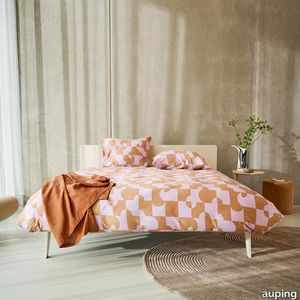
auping > Accessories
Dazzling dreams is a cover made from sustainable cotton satin that is perfect for dreaming away the night in comfort. Graphic shapes in delicate purple and shades of taupe make this cover utterly contemporary. The print continues on the back of the cover and pillowcases. This cover looks fabulous on... Handy: tuck-in strip, hotel closure and button down systemAll Auping duvet covers have an extra long tuck-in strip. This makes it easy to tuck the duvet cover in under your mattress. Cold feet are a thing of the past. You can recognise the extra long tuck-in strip by the length: 200/220The Auping pillowcases of the seasonal collection have a so-called double hotel closure. A hotel closure is a folded opening on the shortest side of the pillowcase. With a double hotel closure, it doesn't matter which side of your pillow you use, it always looks neat.Auping duvet covers and duvets feature the button down system. These are handy buttons and loops that you use to fasten the duvet and cover together, preventing it from shifting. The term button down comes from fashion. It literally means 'buttoned down' and often refers to the buttons on the collar of a shirt that you use to neatly fasten the collar to the shirt. Auping duvet covers have loops on the inside of the cover. Our duvets have buttons in the same places. The loops from the duvet cover can be put around these buttons to prevent the duvet from sliding around in the cover. These buttons and loops also make it easier to make your bed neatly. Sizes of our duvet coversThe sizes of our duvet covers are coordinated with the Auping duvet and pillow range to ensure a perfect match. In addition, the duvet covers and pillowcases are also suitable for most common other duvets and pillows.The Auping duvet covers are available in both single and double sizes:- 140 x 200/220 cm incl. 1 60 x 70 cm pillowcase.- 200 x 200/220 cm incl. 2 pillowcases of 60 x 70 cm.- 240 x 200/220 cm incl. 2 pillowcases of 60 x 70 cm.- 260 x 200/220 cm incl. 2 pillowcases of 60 x 70 cm.Sustainability At Auping, we dream of a rested world. Of sleeping under wonderful bedding made in an environmentally friendly way and under good working conditions. That's why all our duvet covers in the basic collection have the internationally recognised GOTS certificate. This is the very highest international standard for organic textiles. It not only guarantees top quality but also gives us the assurance that the entire chain complies with strict social and environmental requirements. The covers in the seasonal collection carry the BCI label, which also guarantees sustainably and socially responsible bed textile production. Quality labelsNot only sustainability but also the quality of our products is very important to us. We pay a lot of attention to this and work with the following quality marks and institutes to guarantee our quality. All Auping duvet covers are checked annually by TÜV Rheinland Netherlands for size, shrinkage, colour fastness and strength properties.All Auping duvet covers have the Oeko-Tex Standard 100 certificate. This quality mark is issued by the Oeko-Tex institute which guarantees that the tested and certified textiles are free of harmful substances in relation to human health and environmental impact. It is thus a safety seal for textiles.
COSMO 1527 - 3 seater fabric garden sofa _ Et al.
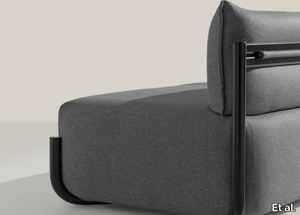
Et al. > Sofa
COSMO 1527 Sofa: Contemporary Elegance for Outdoor Living The COSMO 1527 sofa, designed by Philippe Tabet for Et al., is a three-seater masterpiece that seamlessly blends modern aesthetics with outdoor functionality. Its sleek design and durable construction make it an ideal choice for various settings, including residential patios, hotel terraces, and commercial outdoor lounges. Design and Dimensions The COSMO 1527 features a minimalist silhouette with clean lines and a robust steel frame, ensuring both style and stability. Its dimensions are: Width: 220 cm Depth: 88 cm Height: 80 cm Seat Height: 44 cm These proportions provide ample seating space while maintaining a streamlined profile suitable for various outdoor environments. Materials and Finishes Crafted with high-quality materials, the COSMO 1527 is designed to withstand outdoor conditions: Frame: Constructed from durable steel tubing, treated to resist corrosion and finished in a variety of colors to complement different design schemes. Upholstery: The seat and back are upholstered with weather-resistant fabrics, ensuring comfort and longevity. Available frame finishes include: White Aluminium (NCS S4000-N VR) Jet Black (NCS S9000-N VR) Coral Red (NCS S3060-Y80R) Matt Jet Black (NCS S9000-N VR) Rough Metallic Bronze (VR) Curry (NCS S3060-Y) Olive Green (NCS S7020-G50Y) Water Blue (NCS S4050-B40G) Capri Blue (NCS S6030-B) Brown (NCS S8005-Y20R) Traffic White (NCS S0502-B VR) Marsala (NCS S4040-R) Pewter (VR) Pure White (NCS S0500-N VR) Anthracite Grey (NCS S7502-B VR) These options allow for customization to match specific aesthetic preferences. Applications and Versatility The COSMO 1527's design makes it suitable for a variety of outdoor settings: Residential Spaces: Enhances patios, gardens, and terraces with its modern appeal. Hospitality Environments: Ideal for hotel lounges, poolside areas, and outdoor dining spaces, offering guests a comfortable seating option. Commercial Areas: Suitable for outdoor cafes, restaurants, and rooftop bars, providing durable and stylish seating for patrons. Complementary Products The COSMO collection offers a range of pieces that can be paired with the 1527 sofa to create cohesive outdoor living spaces. Consider the COSMO 1520 armchair or the COSMO 1530 pouf to complete the ensemble. Key Features Modern Design: Clean lines and a minimalist aesthetic enhance contemporary outdoor settings. Durable Construction: Weather-resistant materials ensure longevity in various climates. Customizable Finishes: A wide selection of frame colors allows for personalized design. Comfortable Seating: Upholstered cushions provide comfort for extended outdoor relaxation
COSMO 1522 - 3 seater fabric garden sofa _ Et al.
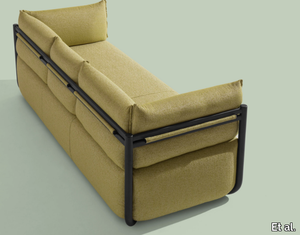
Et al. > Sofa
COSMO 1522 Sofa: Contemporary Elegance for Outdoor Living The COSMO 1522 sofa, designed by Philippe Tabet for Et al., is a three-seater masterpiece that seamlessly blends modern aesthetics with outdoor functionality. Its sleek design and durable construction make it an ideal choice for various settings, including residential patios, hotel terraces, and commercial outdoor lounges. Design and Dimensions The COSMO 1522 features a minimalist silhouette with clean lines and a robust steel frame, ensuring both style and stability. Its dimensions are: Width: 220 cm Depth: 88 cm Height: 80 cm Seat Height: 44 cm These proportions provide ample seating space while maintaining a streamlined profile suitable for various outdoor environments. Materials and Finishes Crafted with high-quality materials, the COSMO 1522 is designed to withstand outdoor conditions: Frame: Constructed from durable steel tubing, treated to resist corrosion and finished in a variety of colors to complement different design schemes. Upholstery: The seat, back, and armrests are upholstered with weather-resistant fabrics, ensuring comfort and longevity. Available frame finishes include: White Aluminium (NCS S4000-N VR) Jet Black (NCS S9000-N VR) Coral Red (NCS S3060-Y80R) Matt Jet Black (NCS S9000-N VR) Rough Metallic Bronze (VR) Curry (NCS S3060-Y) Olive Green (NCS S7020-G50Y) Water Blue (NCS S4050-B40G) Capri Blue (NCS S6030-B) Brown (NCS S8005-Y20R) Traffic White (NCS S0502-B VR) Marsala (NCS S4040-R) Pewter (VR) Pure White (NCS S0500-N VR) Anthracite Grey (NCS S7502-B VR) These options allow for customization to match specific aesthetic preferences. Applications and Versatility The COSMO 1522's design makes it suitable for a variety of outdoor settings: Residential Spaces: Enhances patios, gardens, and terraces with its modern appeal. Hospitality Environments: Ideal for hotel lounges, poolside areas, and outdoor dining spaces, offering guests a comfortable seating option. Commercial Areas: Suitable for outdoor cafes, restaurants, and rooftop bars, providing durable and stylish seating for patrons. Complementary Products The COSMO collection offers a range of pieces that can be paired with the 1522 sofa to create cohesive outdoor living spaces. Consider the COSMO 1520 armchair or the COSMO 1530 pouf to complete the ensemble. Key Features Modern Design: Clean lines and a minimalist aesthetic enhance contemporary outdoor settings. Durable Construction: Weather-resistant materials ensure longevity in various climates. Customizable Finishes: A wide selection of frame colors allows for personalized design. Comfortable Seating: Upholstered cushions provide comfort for extended outdoor relaxation.
COSMO 1533 - Rectangular steel coffee table _ Et al.
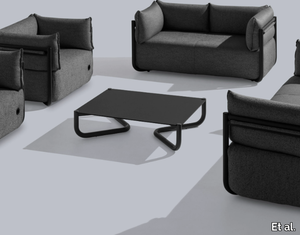
Et al. > Side table
COSMO 1533 Coffee Table: Sleek Minimalism for Modern Spaces The COSMO 1533 coffee table, designed by Philippe Tabet for Et al., embodies minimalist elegance and functionality. Its streamlined design and durable construction make it an ideal addition to various environments, including residential living rooms, hotel lounges, office waiting areas, and outdoor settings. Design and Dimensions The COSMO 1533 features a low-profile silhouette with a steel tube frame and a high-pressure laminate (HPL) top, offering both style and stability. Its dimensions are: Width: 111 cm Depth: 88 cm Height: 29 cm These proportions provide ample surface area while maintaining a compact and unobtrusive presence, suitable for various interior and exterior layouts. Materials and Finishes Crafted with high-quality materials, the COSMO 1533 is designed to withstand both indoor and outdoor conditions: Frame: Constructed from durable steel tubing, treated to resist corrosion and finished in a variety of colors to complement different design schemes. Top: Made from HPL laminate, known for its durability and ease of maintenance, suitable for high-traffic areas. Available frame finishes include: White Aluminium (NCS S4000-N VR) Jet Black (NCS S9000-N VR) Coral Red (NCS S3060-Y80R) Matt Jet Black (NCS S9000-N VR) Rough Metallic Bronze (VR) Curry (NCS S3060-Y) Olive Green (NCS S7020-G50Y) Water Blue (NCS S4050-B40G) Capri Blue (NCS S6030-B) Brown (NCS S8005-Y20R) Traffic White (NCS S0502-B VR) Marsala (NCS S4040-R) Pewter (VR) Pure White (NCS S0500-N VR) Anthracite Grey (NCS S7502-B VR) These options allow for customization to match specific aesthetic preferences. Applications and Versatility The COSMO 1533's design makes it suitable for a variety of settings: Residential Spaces: Enhances living rooms, patios, and terraces with its modern appeal. Hospitality Environments: Ideal for hotel lounges, lobbies, and outdoor seating areas, offering guests a functional and stylish surface. Commercial Areas: Suitable for office waiting rooms, cafes, and retail spaces, providing a durable and elegant table solution. Complementary Products The COSMO collection offers a range of pieces that can be paired with the 1533 coffee table to create cohesive living spaces. Consider the COSMO 1505 armchair or the COSMO 1527 sofa to complete the ensemble. Key Features Modern Design: Clean lines and a minimalist aesthetic enhance contemporary settings. Durable Construction: Weather-resistant materials ensure longevity in various climates. Customizable Finishes: A wide selection of frame colors allows for personalized design. Functional Surface: The HPL laminate top provides a practical and easy-to-maintain surface for everyday use.
COSMO 1525 - Fabric garden armchair _ Et al.
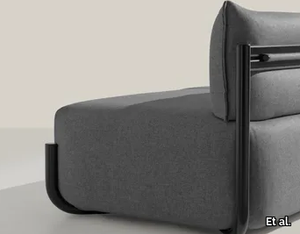
Et al. > Armchair
COSMO 1525 Armchair: Sleek Minimalism for Modern Interiors The COSMO 1525 armchair, designed by Philippe Tabet for Et al., embodies minimalist elegance and versatility. This one-seater armless chair is crafted to seamlessly integrate into various environments, including residential living rooms, hotel lounges, office waiting areas, and outdoor settings. Design and Dimensions The COSMO 1525 features a streamlined design with upholstered seat and backrest, supported by a durable steel frame. Its dimensions are thoughtfully crafted to provide comfort while maintaining a compact footprint: Width: 65 cm Depth: 88 cm Height: 80 cm Seat Height: 44 cm These proportions make it an ideal choice for both spacious and limited areas, offering comfortable seating without overwhelming the space. Materials and Finishes Crafted with precision, the COSMO 1525 offers a range of customization options to suit various design aesthetics: Frame: Constructed from durable steel tubing, ensuring stability and longevity. Upholstery: Available in a diverse selection of high-quality fabrics, including options like Panarea, Reviva Hero, Reviva Iris, Reviva Amelia, and Fabthirty, each offering multiple color choices to complement different interior styles. Frame Finishes: The steel frame can be customized in various finishes, such as White Aluminium (NCS S4000-N VR), Jet Black (NCS S9000-N VR), Coral Red (NCS S3060-Y80R), Matt Jet Black (NCS S9000-N VR), Rough Metallic Bronze (VR), Curry (NCS S3060-Y), Olive Green (NCS S7020-G50Y), Water Blue (NCS S4050-B40G), Capri Blue (NCS S6030-B), Brown (NCS S8005-Y20R), Traffic White (NCS S0502-B VR), Marsala (NCS S4040-R), Pewter (VR), Pure White (NCS S0500-N VR), and Anthracite Grey (NCS S7502-B VR), allowing for seamless integration into any interior color scheme. Functional Accessories To enhance its functionality, the COSMO 1525 can be equipped with optional accessories: Kidney Cushion: Provides additional lumbar support for increased comfort. These accessories make the armchair a practical choice for both relaxation and productivity. Applications and Versatility The COSMO 1525's adaptable design makes it suitable for a variety of settings: Residential Spaces: Ideal for living rooms or bedrooms, adding a touch of modern elegance. Hospitality Environments: Perfect for hotel lobbies, guest rooms, or lounge areas, offering comfort and style to guests. Office and Waiting Areas: Enhances reception spaces or private offices with its sleek design and optional functional accessories. Outdoor Settings: Designed to withstand outdoor conditions, making it suitable for patios, terraces, and garden areas. Complementary Products The COSMO collection includes various seating solutions that can be paired with the 1525 armchair to create cohesive interior designs. Options include the COSMO 1505 armchair, the COSMO 1502 three-seater sofa, and modular systems like the COSMO 1520, allowing for flexible configurations to suit different spaces and requirements. Key Features Modern Aesthetic: Clean lines and minimalist design contribute to a contemporary look. Customizable Finishes: Wide range of upholstery fabrics and frame finishes to match specific design requirements. Optional Accessories: Functional add-ons like kidney cushions enhance usability. Compact Dimensions: Suitable for both large and small spaces without compromising on comfort. High-Quality Construction: Durable materials ensure longevity and sustained aesthetic appeal.
ARI 1310 - Linear module _ Et al.
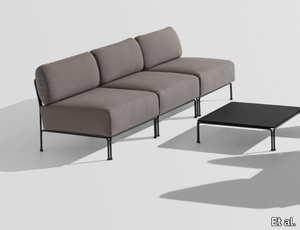
Et al. > Armchair
Ari 1310 Armchair: Modular Elegance for Versatile Spaces The Ari 1310 armchair, designed by Philippe Nigro for Et al., is a testament to minimalist design and modular functionality. As a linear module within the Ari collection, it offers flexibility and style, making it suitable for various environments, including residential living rooms, hotel lounges, office waiting areas, and outdoor settings. Design and Dimensions The Ari 1310 features a sleek silhouette with upholstered seat and backrest, supported by a durable steel frame. Its modular nature allows it to be used independently or combined with other modules to create customized seating arrangements. While specific dimensions are not provided in the available information, the design emphasizes comfort and adaptability, fitting seamlessly into diverse spatial configurations. Materials and Finishes Crafted with precision, the Ari 1310 offers a range of customization options to suit various design aesthetics: Frame: Constructed from durable steel tubing, ensuring stability and longevity. Upholstery: Available in a diverse selection of high-quality fabrics, including options like Melva, Fortis, Inca, Amsterdam, Medley Gabriel, Chili Gabriel, Mirage, Convert, Fenice, Mood Gabriel, Valencia, Fabthirty Rubelli, Ocean Mastrotto, and Remix 3 Kvadrat, each offering multiple color choices to complement different interior styles. Frame Finishes: The steel frame can be customized in various finishes, such as White Aluminium (NCS S4000-N VR), Jet Black (NCS S9000-N VR), Coral Red (NCS S3060-Y80R), Matt Jet Black (NCS S9000-N VR), Rough Metallic Bronze (VR), Curry (NCS S3060-Y), Olive Green (NCS S7020-G50Y), Water Blue (NCS S4050-B40G), Capri Blue (NCS S6030-B), Brown (NCS S8005-Y20R), Traffic White (NCS S0502-B VR), Marsala (NCS S4040-R), Pewter (VR), Pure White (NCS S0500-N VR), and Anthracite Grey (NCS S7502-B VR), allowing for seamless integration into any interior color scheme. Applications and Versatility The Ari 1310's modular design makes it suitable for a variety of settings: Residential Spaces: Ideal for living rooms or bedrooms, adding a touch of modern elegance. Hospitality Environments: Perfect for hotel lobbies, guest rooms, or lounge areas, offering comfort and style to guests. Office and Waiting Areas: Enhances reception spaces or private offices with its sleek design and modular flexibility. Outdoor Settings: Designed to withstand outdoor conditions, making it suitable for patios, terraces, and garden areas. Complementary Products The Ari collection includes various modules that can be paired with the 1310 armchair to create cohesive seating arrangements. Options include the Ari 1300 modular system, the Ari 1311 corner module, and the Ari 1313 pouf, allowing for flexible configurations to suit different spaces and requirements. Key Features Modular Design: Allows for customizable seating arrangements to fit various spaces. Modern Aesthetic: Clean lines and minimalist design contribute to a contemporary look. Customizable Finishes: Wide range of upholstery fabrics and frame finishes to match specific design requirements.
ARI 1311 - Corner armchair _ Et al.
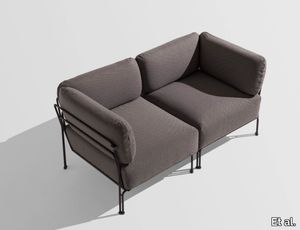
Et al. > Armchair
Ari 1301 Modular Seating System: Versatile Elegance for Diverse Environments The Ari 1301 modular seating system, designed by Philippe Nigro for Et al., epitomizes flexibility and contemporary design. As a terminal corner module within the Ari collection, it seamlessly integrates into various settings, including residential living rooms, hotel lounges, office waiting areas, and outdoor spaces. Design and Dimensions The Ari 1301 features a sleek steel frame supporting upholstered seats, backrests, and armrests, offering both comfort and durability. Its modular nature allows it to function independently or as part of a larger seating arrangement. The specific dimensions are: Weight: 18.3 kg Packaging Volume: 0.57 m³ Pieces per Box: 1 These specifications ensure ease of placement and adaptability in various spatial configurations. Materials and Finishes Crafted with precision, the Ari 1301 offers a range of customization options to suit diverse design aesthetics: Frame: Constructed from durable steel tubing, ensuring stability and longevity. Upholstery: Available in a selection of high-quality outdoor fabrics, including Panarea, 3D Cover, Reviva Hero, Reviva Iris, Reviva Amelia, and Fabthirty, each offering multiple color choices to complement different styles. Frame Finishes: The steel frame can be customized in various finishes, such as White Aluminium (NCS S4000-N VR), Jet Black (NCS S9000-N VR), Coral Red (NCS S3060-Y80R), Matt Jet Black (NCS S9000-N VR), Rough Metallic Bronze (VR), Curry (NCS S3060-Y), Olive Green (NCS S7020-G50Y), Water Blue (NCS S4050-B40G), Capri Blue (NCS S6030-B), Brown (NCS S8005-Y20R), Traffic White (NCS S0502-B VR), Marsala (NCS S4040-R), Pewter (VR), Pure White (NCS S0500-N VR), and Anthracite Grey (NCS S7502-B VR), allowing for seamless integration into any interior or exterior color scheme. Applications and Versatility The Ari 1301's modular design makes it suitable for a variety of settings: Residential Spaces: Ideal for living rooms or patios, adding a touch of modern elegance. Hospitality Environments: Perfect for hotel lobbies, guest rooms, or lounge areas, offering comfort and style to guests. Office and Waiting Areas: Enhances reception spaces or private offices with its sleek design and modular flexibility. Outdoor Settings: Designed to withstand outdoor conditions, making it suitable for terraces and garden areas. Complementary Products The Ari collection includes various modules that can be paired with the 1301 corner module to create cohesive seating arrangements. Options include the Ari 1300 linear module, the Ari 1311 corner module, and the Ari 1313 pouf, allowing for flexible configurations to suit different spaces and requirements. Key Features Modular Design: Allows for customizable seating arrangements to fit various spaces. Modern Aesthetic: Clean lines and minimalist design contribute to a contemporary look. Customizable Finishes: Wide range of upholstery fabrics and frame finishes to match specific design requirements. High-Quality Construction: Durable materials ensure longevity and sustained aesthetic appeal.
Plain Iron
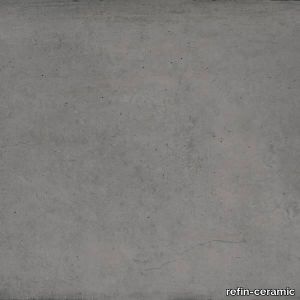
refin-ceramic > Floor tile-stone
Solid SurfaceConcrete is versatile; it comes to life without any shape and because of it provides for countless formal options, from smooth finishes to rough surfaces, with a very diverse aesthetic. A careful research of the many characteristics of this material is the fil rouge to our three solutions, Block, Mold and Plain; these three collections feature different characteristics brought together in the Master Plan.Used by the greatest masters of contemporary architecture, concrete is taking a new role, moving from being a construction material to being a surface finish for architectural projects. Plain stems from analysing concrete in this latter, newer function. The collection stands out for slight clouding and more or less marked patterns, light micro-cracks, that usually form when the concrete volume shrinks by effect of thermal excursion and small holes (pitting) formed by air bubbles trapped between the cast and the formwork. The surface is rich with detailed marks and shades; from a distance it appears as a solid, consistent and compact space.
ARI 1313 - Square pouf _ Et al.
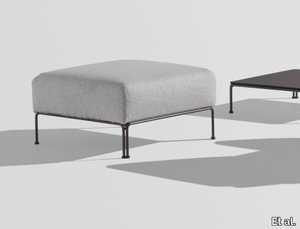
Et al. > Pouf
Ari 1313 Pouf: Versatile Elegance for Modern Interiors The Ari 1313 pouf, designed by Philippe Nigro for Et al., embodies minimalist design and modular functionality. As a key component of the Ari modular seating system, it seamlessly integrates into various environments, including residential living rooms, hotel lounges, office waiting areas, and outdoor settings. Design and Dimensions The Ari 1313 features a sleek silhouette with an upholstered seat supported by a durable steel frame. Its modular nature allows it to be used independently as a standalone piece or combined with other modules to create customized seating arrangements. While specific dimensions are not provided in the available information, the design emphasizes comfort and adaptability, fitting seamlessly into diverse spatial configurations. Materials and Finishes Crafted with precision, the Ari 1313 offers a range of customization options to suit various design aesthetics: Frame: Constructed from durable steel tubing, ensuring stability and longevity. Upholstery: Available in a diverse selection of high-quality fabrics, including options like Melva, Fortis, Inca, Amsterdam, Medley Gabriel, Chili Gabriel, Mirage, Convert, Fenice, Mood Gabriel, Valencia, Fabthirty Rubelli, Ocean Mastrotto, and Remix 3 Kvadrat, each offering multiple color choices to complement different interior styles. Frame Finishes: The steel frame can be customized in various finishes, such as White Aluminium (NCS S4000-N VR), Jet Black (NCS S9000-N VR), Coral Red (NCS S3060-Y80R), Matt Jet Black (NCS S9000-N VR), Rough Metallic Bronze (VR), Curry (NCS S3060-Y), Olive Green (NCS S7020-G50Y), Water Blue (NCS S4050-B40G), Capri Blue (NCS S6030-B), Brown (NCS S8005-Y20R), Traffic White (NCS S0502-B VR), Marsala (NCS S4040-R), Pewter (VR), Pure White (NCS S0500-N VR), and Anthracite Grey (NCS S7502-B VR), allowing for seamless integration into any interior color scheme. Applications and Versatility The Ari 1313's modular design makes it suitable for a variety of settings: Residential Spaces: Ideal for living rooms or bedrooms, adding a touch of modern elegance. Hospitality Environments: Perfect for hotel lobbies, guest rooms, or lounge areas, offering comfort and style to guests. Office and Waiting Areas: Enhances reception spaces or private offices with its sleek design and modular flexibility. Outdoor Settings: Designed to withstand outdoor conditions, making it suitable for patios, terraces, and garden areas. Complementary Products The Ari collection includes various modules that can be paired with the 1313 pouf to create cohesive seating arrangements. Options include the Ari 1300 linear module, the Ari 1311 corner module, and the Ari 1312 armchair, allowing for flexible configurations to suit different spaces and requirements. Key Features Modular Design: Allows for customizable seating arrangements to fit various spaces. Modern Aesthetic: Clean lines and minimalist design contribute to a contemporary look. Customizable Finishes: Wide range of upholstery fabrics and frame finishes to match specific design requirements.
LARRY - 3 seater sofa bed _ Milano Bedding
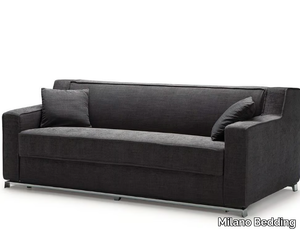
Milano Bedding > Sofa
LARRY by Milano Bedding – Clean Lines, Wide Armrests, and Real-Bed Comfort Name: Larry Material: Solid wood frame, polyurethane foam, steel Lampolet mechanism Finishing: Fixed or removable fabric/leather upholstery, painted metal legs Sizes (cm): Width 190–225 | Depth 100 | Height 84 | Bed size 140×200 or 160×200 Weight: Approx. 115–130 kg Designed in: Italy Collection: Milano Bedding Sofa Beds Lead Time: 30 days 2D/3D Files: Available for download Robust Elegance with Hidden Functionality The Larry sofa bed by Milano Bedding brings together modern simplicity, broad proportions, and exceptional comfort. Its signature features—generous armrests, linear structure, and deep seat—make it ideal for urban residences, design hotels, and serviced apartments. Inside, Larry hides a high-quality 17 cm thick mattress that unfolds easily using the brand’s patented Lampolet mechanism. The bed opens in one motion, without removing seat or back cushions, offering a true sleeping solution suitable for everyday use. Materials, Upholstery & Build Quality Constructed with a solid wood frame and a durable steel opening system, Larry is built for longevity in both private and contract settings. The seat and back cushions are made of polyurethane foam in differentiated densities, ensuring balanced support and comfort. The sofa is available with removable or fixed upholstery, in Milano Bedding’s wide range of fabrics and leathers. From neutral wools and natural linens to bold velvets and contract-grade textiles, the material palette allows Larry to blend into any interior design vision. Slim painted metal legs support the structure while adding a sleek, modern edge. Suitable for Hospitality, Residential & Contract Projects Larry’s clean form and smart proportions make it a perfect match for: Hotel rooms, suites, and short-stay apartments Luxury rentals, co-living spaces, or student housing Home offices, family lounges, or guest bedrooms Reception lounges or creative studio waiting areas Its wide armrests and structured shape make it ideal for larger rooms that need a grounding, comfortable anchor piece that’s also highly functional. Visual Style & Interior Harmony Larry’s aesthetic is firmly rooted in contemporary minimalism with a touch of architectural solidity. The strong geometry, broad armrests, and deep seat work well in Scandinavian, Japandi, or urban loft-style interiors. Whether upholstered in monochrome fabrics for a minimalist look or in rich hues for a bolder presence, Larry adapts easily. It can serve as the focal point of a lounge or blend harmoniously into a layered residential palette. Key Features & Optional Elements Converts to a 140×200 cm or 160×200 cm bed 17 cm thick mattress in polyurethane or memory foam Quick-open Lampolet mechanism – no need to remove cushions Available with removable covers for contract use Optional headrests, scatter cushions, and bolsters on request Alternatives with Similar Functionality Looking for variations in size or styling? Explore: Goodman – More compact geometry with minimalist arms Marsalis – Mid-century style with elegant structure Charles – Slim profile for smaller spaces Jarreau – Deep seat and sculptural shape for bold interiors All Milano Bedding products include 2D and 3D files to simplify space planning and client presentations. Larry by Milano Bedding is the ideal solution when you need a generously proportioned, modern sofa bed that combines comfort, visual impact, and daily performance—perfect for both refined residential and demanding hospitality environments.
COSMO 1507 - 3 seater fabric sofa _ Et al.
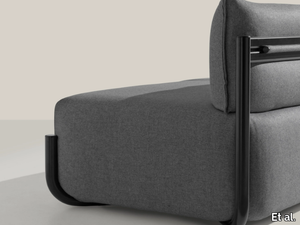
Et al. > Sofa
COSMO 1507 Sofa: A Contemporary Three-Seater Masterpiece The COSMO 1507 sofa, designed by Philippe Tabet for Et al., epitomizes modern elegance and versatility. This armless three-seater sofa seamlessly integrates into various interior settings, including residential living rooms, hotel lounges, office waiting areas, and upscale retail spaces. Design and Dimensions The COSMO 1507 boasts a sleek and minimalist design, characterized by its armless structure and plush upholstery. Its dimensions are thoughtfully crafted to provide comfort while maintaining a compact footprint: Width: 237 cm Depth: 88 cm Height: 80 cm Seat Height: 44 cm These proportions make it an ideal choice for both spacious and limited areas, offering ample seating without overwhelming the space. Materials and Finishes Crafted with precision, the COSMO 1507 features: Frame: Constructed from durable steel tubing, ensuring stability and longevity. Upholstery: Available in a diverse range of high-quality fabrics, including options like Melva, Fortis, Inca, Medley Gabriel, Chili Gabriel, Mirage, Convert, Fenice, Mood Gabriel, Valencia, Fabthirthy Rubelli, Ocean Mastrotto, and Remix 3 Kvadrat, each offering multiple color choices to suit various design aesthetics. Frame Finishes: The steel frame can be customized in various finishes, such as White Aluminium (NCS S4000-N VR), Jet Black (NCS S9000-N VR), Coral Red (NCS S3060-Y80R), Matt Jet Black (NCS S9000-N VR), Rough Metallic Bronze (VR), Curry (NCS S3060-Y), Olive Green (NCS S7020-G50Y), Water Blue (NCS S4050-B40G), Capri Blue (NCS S6030-B), Brown (NCS S8005-Y20R), Traffic White (NCS S0502-B VR), Marsala (NCS S4040-R), Pewter (VR), Pure White (NCS S0500-N VR), and Anthracite Grey (NCS S7502-B VR), allowing for seamless integration into any interior color scheme. Functional Accessories To enhance its functionality, the COSMO 1507 can be equipped with optional accessories: Kidney Cushion: Provides additional lumbar support for increased comfort. Reading Lamp: An integrated light source suitable for reading or creating ambient lighting. USB Socket: Convenient for charging electronic devices, making it suitable for modern living and working environments. Schuko Socket: Offers an additional power outlet for various needs. These accessories make the sofa a practical choice for both relaxation and productivity. Applications and Versatility The COSMO 1507's adaptable design makes it suitable for a variety of settings: Residential Spaces: Ideal for living rooms or bedrooms, adding a touch of modern elegance. Hospitality Environments: Perfect for hotel lobbies, guest rooms, or lounge areas, offering comfort and style to guests. Office and Waiting Areas: Enhances reception spaces or private offices with its sleek design and optional functional accessories. Retail Spaces: Complements boutique stores or showrooms, providing a comfortable seating option for customers. Complementary Products The COSMO collection includes various seating solutions that can be paired with the 1507 sofa to create cohesive interior designs. Options include the COSMO 1505 armchair, the COSMO 1502 three-seater sofa, and modular systems like the COSMO 1520, allowing for flexible configurations to suit different spaces and requirements. Key Features Modern Aesthetic: Clean lines and armless design contribute to a minimalist and contemporary look. Customizable Finishes: Wide range of upholstery fabrics and frame finishes to match specific design requirements. Optional Accessories: Functional add-ons like reading lamps and USB sockets enhance usability. Compact Dimensions: Suitable for both large and small spaces without compromising on comfort. High-Quality Construction: Durable materials ensure longevity and sustained aesthetic appeal.
ARI 1320 - Upholstered fabric chair with armrests _ Et al.
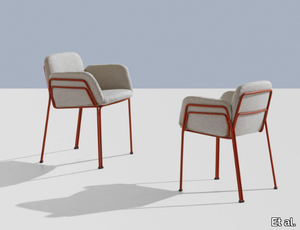
Et al. > Chair
Ari 1320 Armchair: Outdoor Elegance with Modular Flexibility The Ari 1320 armchair, designed by Philippe Nigro for Et al., exemplifies minimalist design and modular functionality. As a standout piece in the Ari outdoor collection, it seamlessly integrates into various environments, including residential patios, hotel terraces, restaurant courtyards, and office outdoor lounges. Design and Dimensions The Ari 1320 features a sleek steel frame supporting upholstered seat, back, and armrests, offering both comfort and durability. Its modular nature allows it to function independently or as part of a larger seating arrangement. While specific dimensions are not provided in the available information, the design emphasizes comfort and adaptability, fitting seamlessly into diverse spatial configurations. Materials and Finishes Crafted with precision, the Ari 1320 offers a range of customization options to suit various design aesthetics: Frame: Constructed from durable steel tubing, ensuring stability and longevity. Upholstery: Available in a selection of high-quality outdoor fabrics, including Panarea (+4 colors), Reviva Hero (+5 colors), Reviva Iris (+7 colors), Reviva Amelia (+5 colors), and Fabthirty (+6 colors), each offering multiple color choices to complement different styles. Frame Finishes: The steel frame can be customized in various finishes, such as White Aluminium (NCS S4000-N VR), Jet Black (NCS S9000-N VR), Coral Red (NCS S3060-Y80R), Matt Jet Black (NCS S9000-N VR), Rough Metallic Bronze (VR), Curry (NCS S3060-Y), Olive Green (NCS S7020-G50Y), Water Blue (NCS S4050-B40G), Capri Blue (NCS S6030-B), Brown (NCS S8005-Y20R), Traffic White (NCS S0502-B VR), Marsala (NCS S4040-R), and Anthracite Grey (NCS S7502-B VR), allowing for seamless integration into any outdoor color scheme. Applications and Versatility The Ari 1320's design makes it suitable for a variety of outdoor settings: Residential Spaces: Ideal for patios, gardens, and terraces, adding a touch of modern elegance. Hospitality Environments: Perfect for hotel courtyards, poolside areas, and outdoor lounges, offering comfort and style to guests. Restaurants and Cafés: Enhances outdoor dining areas with its sleek design and durability. Office Outdoor Areas: Suitable for creating comfortable outdoor break spaces for employees. Complementary Products The Ari collection includes various modules that can be paired with the 1320 armchair to create cohesive seating arrangements. Options include the Ari 1300 linear module, the Ari 1311 corner module, and the Ari 1313 pouf, allowing for flexible configurations to suit different spaces and requirements. Key Features Outdoor Durability: Designed to withstand outdoor conditions, ensuring longevity and sustained aesthetic appeal. Modular Design: Allows for customizable seating arrangements to fit various spaces. Modern Aesthetic: Clean lines and minimalist design contribute to a contemporary look. Customizable Finishes: Wide range of upholstery fabrics and frame finishes to match specific design requirements.
COSMO 1526 - 2 seater fabric garden sofa _ Et al.
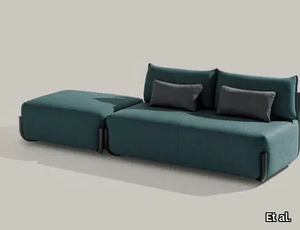
Et al. > Sofa
COSMO 1526 Sofa: Contemporary Elegance for Versatile Spaces The COSMO 1526 sofa, designed by Philippe Tabet for Et al., epitomizes modern design and adaptability. This two-seater sofa, without armrests, is crafted to seamlessly integrate into various environments, including residential living rooms, hotel lounges, office waiting areas, and outdoor settings. Design and Dimensions The COSMO 1526 features a sleek and minimalist design, characterized by its upholstered seat and backrest, all supported by a durable steel frame. Its dimensions are thoughtfully crafted to provide comfort while maintaining a compact footprint: Width: 111 cm Depth: 88 cm Height: 80 cm Seat Height: 44 cm These proportions make it an ideal choice for both spacious and limited areas, offering ample seating without overwhelming the space. Materials and Finishes Crafted with precision, the COSMO 1526 offers a range of customization options to suit various design aesthetics: Frame: Constructed from durable steel tubing, ensuring stability and longevity. Upholstery: Available in a diverse selection of high-quality fabrics, including options like Panarea, Reviva Hero, Reviva Iris, Reviva Amelia, and Fabthirty, each offering multiple color choices to complement different interior styles. Frame Finishes: The steel frame can be customized in various finishes, such as White Aluminium (NCS S4000-N VR), Jet Black (NCS S9000-N VR), Coral Red (NCS S3060-Y80R), Matt Jet Black (NCS S9000-N VR), Rough Metallic Bronze (VR), Curry (NCS S3060-Y), Olive Green (NCS S7020-G50Y), Water Blue (NCS S4050-B40G), Capri Blue (NCS S6030-B), Brown (NCS S8005-Y20R), Traffic White (NCS S0502-B VR), Marsala (NCS S4040-R), Pewter (VR), Pure White (NCS S0500-N VR), and Anthracite Grey (NCS S7502-B VR), allowing for seamless integration into any interior color scheme. Functional Accessories To enhance its functionality, the COSMO 1526 can be equipped with optional accessories: Kidney Cushion: Provides additional lumbar support for increased comfort. These accessories make the sofa a practical choice for both relaxation and productivity. Applications and Versatility The COSMO 1526's adaptable design makes it suitable for a variety of settings: Residential Spaces: Ideal for living rooms or bedrooms, adding a touch of modern elegance. Hospitality Environments: Perfect for hotel lobbies, guest rooms, or lounge areas, offering comfort and style to guests. Office and Waiting Areas: Enhances reception spaces or private offices with its sleek design and optional functional accessories. Outdoor Settings: Designed to withstand outdoor conditions, making it suitable for patios, terraces, and garden areas. Complementary Products The COSMO collection includes various seating solutions that can be paired with the 1526 sofa to create cohesive interior designs. Options include the COSMO 1505 armchair, the COSMO 1502 three-seater sofa, and modular systems like the COSMO 1520, allowing for flexible configurations to suit different spaces and requirements. Key Features Modern Aesthetic: Clean lines and minimalist design contribute to a contemporary look. Customizable Finishes: Wide range of upholstery fabrics and frame finishes to match specific design requirements. Optional Accessories: Functional add-ons like kidney cushions enhance usability. Compact Dimensions: Suitable for both large and small spaces without compromising on comfort. High-Quality Construction: Durable materials ensure longevity and sustained aesthetic appeal. Conclusion
Archeologie Archeologie Grigio
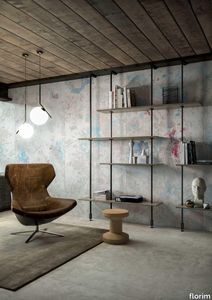
florim > Wall Paint
The poetics of the wall. The forgotten wall. «A wall is like a book to be opened, a journey into the interior, revealing the experiences, memories, signs and symbols which this fragment of masonry has absorbed over the centuries.» Franco Guerzoni <p>It is difficult to resist the beauty of Franco Guerzoni's art, created by a rare harmony of feeling and intellect, poetry and mind. The artist expresses this through paintings which, although complex in structure, are joyous and sensual, with bright colours made, like those of the great masters of the past, from choice powdered ingredients. A painter with a technique rich in traditional skills, Guerzoni offers a version of modernity involving an intense fundamental relationship with his images and with space. In fact, the dialectic between painting and space, form and architecture, time and memory seems to be essential to his art. As his works specifically created for CEDIT clearly express, his creations achieve a perfect balance between the spatial dimension and intensely lyrical use of colour, which here becomes a soft, liquid form of matter, wandering across the surface of a dazzling lime-plaster white. White, metaphor for the clear light of day, as it was in the large, complex canvases exhibited in his personal exhibition at the 1990 Venice Biennale, is the background for forms of colour which renew the pleasure to be had from painting and the memory of an image glimpsed on the vast expanse of the surface. In the more recent works, these voluptuous shades are transformed into subtle shadows of colour that delicately caress the surface.</p> <p> </p> <p> All it takes is one wall, the only surviving wall of what was once a house, on which time has recorded its own, unavoidable passing, leaving traces of colour that is still vibrant, although faded in places, to allow the memory of the image to transpire, fragile and uncertain, in the physicality of the surface, to bear tangible witness to the existence of history, a mysterious visual memory, the extension into the present of the life of things. A memory of the past on a contemporary wall. The idea of memory is central to Franco Guerzoni's poetics: private, secret memory and the collective memory of the past. Fragmentary and indecipherable, perceived by the artist with the aid of what is left of the images, the fragment. A relic of a totality which can no longer be reconstructed but only imagined in poetic terms, the fragment, a fraction of an image conserved by time, guides the artist's fantastic archaeological journey in search of the world's memory. However, this journey takes him in the opposite direction to the archaeologist, for whom the fragment - fundamental because it reveals a trace of the past is the starting-point for an attempt to reconstruct history. For Guerzoni, the fragment is the endpoint of his work, the goal for which he strives in his investigation of the surface, as he digs deep down, leafing through the deposits of time and memory.</p> <p> </p> <p>Like the large pages of a book traced with fragile sketches, embryonic forms whose meaning has been lost in time, leaving only fleeting traces, uncertain, ambiguous, mysterious morphologies. It marks the start of a journey into the mind of the artist-archaeologist, an adventurous journey into the inextricable labyrinth of the mind, to unearth what is hidden, shuffling the cards in a perennial contamination of images, memory, signs and traces, in search of a meaning, which no sooner appears than it is lost, merging into time and once again becoming a dream, an imaginary journey into fantasy and wonder. And this is the case in the tryptic created for CEDIT, which placed a new challenge before the artist: to transfer "his" image, the remains and fragments of a forgotten wall onto a new material for him “stunning, large-sized ceramic slabs“ and a real wall, without this tautology betraying the painting's deep meaning, its fertile magic of lines and colours, from which the image is born. And the artist is fully aware of this. Guerzoni describes his art as a "gamble": a gamble that is a critical test, an act of daring, dangerous and risky. This is the challenge he sets himself. It is a challenge he easily overcomes, expressing himself on these large walls with a rediscovered pleasure in painting, no longer restrained and apparently absorbed by the dense, uneven coloured surface but set free and almost luxuriously accentuated. In his large, demanding works for CEDIT, Guerzoni achieves a new, consummate mode of painting, in which the architecture of the surfaces provides a poetic meeting-point between the two founding components of his style, the complex, well thought-out composition and the lyricism of colour.</p>
Bright bliss Pillowcases
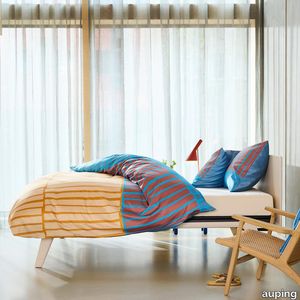
auping > Accessories
The Bright bliss pillowcases are made of 100% cotton satin. The coloured stripes on the front of the pillowcases blend into the duvet cover. The back of the pillowcases are plain blue like the colour in the sea. Pillowcase with double hotel closureThe Auping pillowcases from the seasonal collection have what is known as a double hotel closure. A hotel closure is a folded opening on the shortest side of the pillowcase. With a double hotel closure, it doesn't matter which side of your pillow you use, it always looks neat. Sizes of our pillowcasesThe pillowcases from the basic collection and seasonal collection are also available as a loose set in sizes:60 x 70 cm40 x 60 cmSustainability At Auping, we dream of a rested world. Of sleeping under wonderful bedding made in an environmentally friendly way and under good working conditions. That's why all our duvet covers in the basic collection have the internationally recognised GOTS certificate. This is the very highest international standard for organic textiles. It not only guarantees top quality but also gives us the assurance that the entire chain complies with strict social and environmental requirements. The covers in the seasonal collection carry the BCI label, which also guarantees sustainably and socially responsible produced bed textiles.Quality labelsNot only sustainability but also the quality of our products is very important to us. We pay a lot of attention to this and work with the following quality marks and institutes to guarantee our quality. All Auping duvet covers are checked annually by TÜV Rheinland Netherlands for size, shrinkage, colour fastness and strength properties.All Auping duvet covers have the Oeko-Tex Standard 100 certificate. This quality mark is issued by the Oeko-Tex institute which guarantees that the tested and certified textiles are free of harmful substances in relation to human health and environmental impact. It is thus a safety seal for textiles.
Dynamic colours Pillowcases
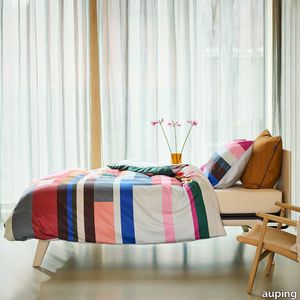
auping > Accessories
The Dynamic colours pillowcases are made of 100% cotton satin. The coloured stripes on the front of the pillowcases blend into the duvet cover. The back of the pillowcases are plain brown. Pillowcase with double hotel closureThe Auping pillowcases from the seasonal collection have what is known as a double hotel closure. A hotel closure is a folded opening on the shortest side of the pillowcase. With a double hotel closure, it doesn't matter which side of your pillow you use, it always looks neat.Sizes of our pillowcasesThe pillowcases from the basic collection and seasonal collection are also available as a loose set in sizes:60 x 70 cm40 x 60 cmSustainabilityAt Auping, we dream of a rested world. Of sleeping under wonderful bedding made in an environmentally friendly way and under good working conditions. That's why all our duvet covers in the basic collection have the internationally recognised GOTS certificate. This is the very highest international standard for organic textiles. It not only guarantees top quality but also gives us the assurance that the entire chain complies with strict social and environmental requirements. The covers in the seasonal collection carry the BCI label, which also guarantees sustainably and socially responsible produced bed textiles.Quality labelsNot only sustainability but also the quality of our products is very important to us. We pay a lot of attention to this and work with the following quality marks and institutes to guarantee our quality. All Auping duvet covers are checked annually by TÜV Rheinland Netherlands for size, shrinkage, colour fastness and strength properties.All Auping duvet covers have the Oeko-Tex Standard 100 certificate. This quality mark is issued by the Oeko-Tex institute which guarantees that the tested and certified textiles are free of harmful substances in relation to human health and environmental impact. It is thus a safety seal for textiles.
DAVE - 2 seater sofa bed _ Milano Bedding
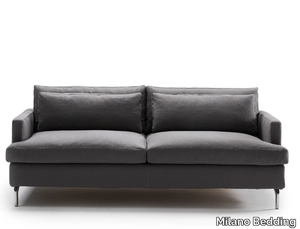
Milano Bedding > Sofa
DAVE by Milano Bedding – Slim Arm Sofa Bed with Contemporary Elegance and Real-Bed Comfort Name: Dave Material: Solid wood frame, polyurethane foam, steel Lampolet mechanism Finishing: Fixed or removable fabric/leather upholstery, matt black or bronze metal legs Sizes (cm): Width 180–210 | Depth 100 | Height 80 | Bed size 140×200 or 160×200 Weight: Approx. 105–120 kg Designed in: Italy Collection: Milano Bedding Sofa Beds Lead Time: 30 days 2D/3D Files: Available for download Slim Profile, Full Comfort The Dave sofa bed by Milano Bedding is a stylish, space-efficient solution designed with slim arms, clean geometry, and an understated elegance. Ideal for hotels, serviced apartments, and urban residences, Dave combines a sharp silhouette with real-bed performance. Despite its narrow footprint, Dave conceals a 17 cm thick mattress and a quick-opening Lampolet mechanism, transforming the sofa into a proper bed with minimal effort—no need to remove cushions. Structure, Materials & Upholstery Options Built on a solid wood frame with a reinforced steel folding system, Dave ensures durability in high-traffic or contract use. The seat and back cushions are made of polyurethane foam in differentiated densities, offering supportive seating and quality rest. Available in fixed or removable upholstery, Dave can be specified in Milano Bedding’s wide selection of fabrics or leathers. Choose from neutral linens, velvets, or performance textiles to suit your project’s look and functional needs. The matt metal legs, in black or bronze, enhance the piece’s modern, architectural feel. Designed for Hospitality, Office, and Residential Interiors Thanks to its slim arms and reduced overall width, Dave is ideal for: Hotel rooms or serviced studios needing compact yet luxurious furniture Short-term rentals and holiday apartments Guest rooms, multi-use spaces, or home offices Residential interiors where a full bed is needed without occupying excess space Waiting areas or executive lounges with occasional sleeping needs Dave’s dimensions allow for excellent use of space, especially in rooms where traditional sofa beds would feel bulky. Visual Character & Style Pairings With its linear form, minimal detailing, and architectural legs, Dave fits beautifully into Scandinavian, Japandi, contemporary, and even transitional interiors. Its versatility makes it easy to style: pair with a wool throw and ceramic side table for Nordic charm or use leather upholstery and brass lighting for a more refined, urban look. It’s understated enough to blend in, yet structured enough to elevate the room. Key Features & Customisation Mattress sizes: 140×200 cm or 160×200 cm 17 cm thick mattress in polyurethane or memory foam Quick-open Lampolet mechanism, no cushion removal required Optional removable cover for hygiene and easy care Available with headrests, scatter cushions, or decorative bolsters Explore Other Models If Dave’s slim arms and modern form appeal to you, you may also consider: Ellington – Classic structure with a compact silhouette Oliver – Timeless, simple design with tailored edges Goodman – A more generous look with minimalist detailing Marsalis – A sharper, mid-century inspired version All Milano Bedding models include 2D and 3D files to simplify integration into technical drawings, visualisations, and moodboards.
Vibrant apricot Duvet Cover
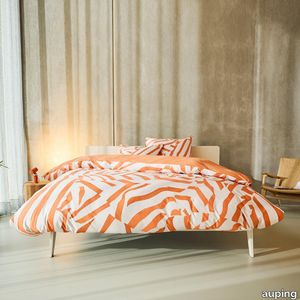
auping > Accessories
This cotton satin cover features playful stripes in the on-trend colour of apricot. The background is a light beige print that almost looks woven. Both the back of the cover and the pillowcases are a solid orange colour. Want to give your bed an extra dose of style? Add a few pillowcases in Brilliant... Handy: tuck-in strip, hotel closure and button down systemAll Auping duvet covers have an extra long tuck-in strip. This makes it easy to tuck the duvet cover in under your mattress. Cold feet are a thing of the past. You can recognise the extra long tuck-in strip by the length: 200/220The Auping pillowcases of the seasonal collection have a so-called double hotel closure. A hotel closure is a folded opening on the shortest side of the pillowcase. With a double hotel closure, it doesn't matter which side of your pillow you use, it always looks neat.Auping duvet covers and duvets feature the button down system. These are handy buttons and loops that you use to fasten the duvet and cover together, preventing it from shifting. The term button down comes from fashion. It literally means 'buttoned down' and often refers to the buttons on the collar of a shirt that you use to neatly fasten the collar to the shirt. Auping duvet covers have loops on the inside of the cover. Our duvets have buttons in the same places. The loops from the duvet cover can be put around these buttons to prevent the duvet from sliding around in the cover. These buttons and loops also make it easier to make your bed neatly. Sizes of our duvet coversThe sizes of our duvet covers are coordinated with the Auping duvet and pillow range to ensure a perfect match. In addition, the duvet covers and pillowcases are also suitable for most common other duvets and pillows.The Auping duvet covers are available in both single and double sizes:- 140 x 200/220 cm incl. 1 60 x 70 cm pillowcase.- 200 x 200/220 cm incl. 2 pillowcases of 60 x 70 cm.- 240 x 200/220 cm incl. 2 pillowcases of 60 x 70 cm.- 260 x 200/220 cm incl. 2 pillowcases of 60 x 70 cm.Sustainability At Auping, we dream of a rested world. Of sleeping under wonderful bedding made in an environmentally friendly way and under good working conditions. That's why all our duvet covers in the basic collection have the internationally recognised GOTS certificate. This is the very highest international standard for organic textiles. It not only guarantees top quality but also gives us the assurance that the entire chain complies with strict social and environmental requirements. The covers in the seasonal collection carry the BCI label, which also guarantees sustainably and socially responsible bed textile production. Quality labelsNot only sustainability but also the quality of our products is very important to us. We pay a lot of attention to this and work with the following quality marks and institutes to guarantee our quality. All Auping duvet covers are checked annually by TÜV Rheinland Netherlands for size, shrinkage, colour fastness and strength properties.All Auping duvet covers have the Oeko-Tex Standard 100 certificate. This quality mark is issued by the Oeko-Tex institute which guarantees that the tested and certified textiles are free of harmful substances in relation to human health and environmental impact. It is thus a safety seal for textiles.
COSMO 1515 Side Table: A Modern Laptop Table
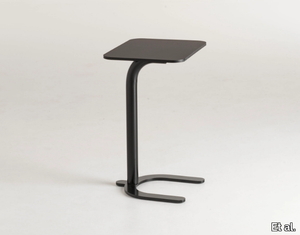
Et al. > Coffee table
COSMO 1515 Side Table: A Modern Accent for Contemporary Spaces The COSMO 1515 side table, designed by Philippe Tabet for Et al., embodies minimalist elegance and functionality, making it a versatile addition to various interior settings, including residential living rooms, hotel lounges, office waiting areas, and educational environments. Design and Dimensions The COSMO 1515 features a sleek steel frame paired with a durable HPL (High-Pressure Laminate) tabletop, offering a modern aesthetic that complements a wide range of interior styles. Its compact dimensions are: Width: 50 cm Depth: 50 cm Height: 50 cm These proportions make it an ideal choice for both spacious and limited areas, providing a functional surface without overwhelming the space. Materials and Finishes Crafted with precision, the COSMO 1515 comprises: Frame: Constructed from durable steel tubing, ensuring stability and longevity. Tabletop: Made from high-pressure laminate (HPL), known for its durability and resistance to scratches and stains, making it ideal for high-traffic areas. The steel frame is available in a variety of finishes, allowing for customization to match specific design aesthetics. Options include: White Aluminium (NCS S4000-N VR) Jet Black (NCS S9000-N VR) Coral Red (NCS S3060-Y80R) Matt Jet Black (NCS S9000-N VR) Rough Metallic Bronze (VR) Curry (NCS S3060-Y) Olive Green (NCS S7020-G50Y) Water Blue (NCS S4050-B40G) Capri Blue (NCS S6030-B) Brown (NCS S8005-Y20R) Traffic White (NCS S0502-B VR) Marsala (NCS S4040-R) Pewter (VR) Pure White (NCS S0500-N VR) Anthracite Grey (NCS S7502-B VR) These finish options enable the COSMO 1515 to seamlessly integrate into diverse interior color schemes and styles. Applications and Versatility The COSMO 1515's adaptable design makes it suitable for a variety of settings: Residential Spaces: Serves as a stylish accent table in living rooms, bedrooms, or reading nooks, complementing sofas and seating arrangements. Hospitality Environments: Ideal for hotel lobbies, lounges, and guest rooms, providing a functional surface for guests. Office and Waiting Areas: Enhances reception spaces and meeting rooms with its sleek design and practical surface area. Educational Settings: Suitable for libraries, study areas, or common rooms, offering a durable and functional surface for various activities. Complementary Products The COSMO collection includes various seating solutions that can be paired with the 1515 side table to create cohesive interior designs. Options include the COSMO 1505 armchair, the COSMO 1502 three-seater sofa, and modular systems like the COSMO 1520, allowing for flexible configurations to suit different spaces and requirements. Key Features Modern Aesthetic: Clean lines and minimalist design contribute to a contemporary look. Customizable Finishes: Wide range of frame finishes to match specific design requirements. Durable Materials: High-quality steel frame and HPL tabletop ensure longevity and resistance to wear. Compact Dimensions: Suitable for both large and small spaces without compromising on functionality. High-Quality Construction: Durable materials ensure longevity and sustained aesthetic appeal.
Archeologie Archeologie Bianco

florim > Wall Paint
The poetics of the wall. The forgotten wall. «A wall is like a book to be opened, a journey into the interior, revealing the experiences, memories, signs and symbols which this fragment of masonry has absorbed over the centuries.» Franco Guerzoni <p>It is difficult to resist the beauty of Franco Guerzoni's art, created by a rare harmony of feeling and intellect, poetry and mind. The artist expresses this through paintings which, although complex in structure, are joyous and sensual, with bright colours made, like those of the great masters of the past, from choice powdered ingredients. A painter with a technique rich in traditional skills, Guerzoni offers a version of modernity involving an intense fundamental relationship with his images and with space. In fact, the dialectic between painting and space, form and architecture, time and memory seems to be essential to his art. As his works specifically created for CEDIT clearly express, his creations achieve a perfect balance between the spatial dimension and intensely lyrical use of colour, which here becomes a soft, liquid form of matter, wandering across the surface of a dazzling lime-plaster white. White, metaphor for the clear light of day, as it was in the large, complex canvases exhibited in his personal exhibition at the 1990 Venice Biennale, is the background for forms of colour which renew the pleasure to be had from painting and the memory of an image glimpsed on the vast expanse of the surface. In the more recent works, these voluptuous shades are transformed into subtle shadows of colour that delicately caress the surface.</p> <p> </p> <p> All it takes is one wall, the only surviving wall of what was once a house, on which time has recorded its own, unavoidable passing, leaving traces of colour that is still vibrant, although faded in places, to allow the memory of the image to transpire, fragile and uncertain, in the physicality of the surface, to bear tangible witness to the existence of history, a mysterious visual memory, the extension into the present of the life of things. A memory of the past on a contemporary wall. The idea of memory is central to Franco Guerzoni's poetics: private, secret memory and the collective memory of the past. Fragmentary and indecipherable, perceived by the artist with the aid of what is left of the images, the fragment. A relic of a totality which can no longer be reconstructed but only imagined in poetic terms, the fragment, a fraction of an image conserved by time, guides the artist's fantastic archaeological journey in search of the world's memory. However, this journey takes him in the opposite direction to the archaeologist, for whom the fragment - fundamental because it reveals a trace of the past is the starting-point for an attempt to reconstruct history. For Guerzoni, the fragment is the endpoint of his work, the goal for which he strives in his investigation of the surface, as he digs deep down, leafing through the deposits of time and memory.</p> <p> </p> <p>Like the large pages of a book traced with fragile sketches, embryonic forms whose meaning has been lost in time, leaving only fleeting traces, uncertain, ambiguous, mysterious morphologies. It marks the start of a journey into the mind of the artist-archaeologist, an adventurous journey into the inextricable labyrinth of the mind, to unearth what is hidden, shuffling the cards in a perennial contamination of images, memory, signs and traces, in search of a meaning, which no sooner appears than it is lost, merging into time and once again becoming a dream, an imaginary journey into fantasy and wonder. And this is the case in the tryptic created for CEDIT, which placed a new challenge before the artist: to transfer "his" image, the remains and fragments of a forgotten wall onto a new material for him “stunning, large-sized ceramic slabs“ and a real wall, without this tautology betraying the painting's deep meaning, its fertile magic of lines and colours, from which the image is born. And the artist is fully aware of this. Guerzoni describes his art as a "gamble": a gamble that is a critical test, an act of daring, dangerous and risky. This is the challenge he sets himself. It is a challenge he easily overcomes, expressing himself on these large walls with a rediscovered pleasure in painting, no longer restrained and apparently absorbed by the dense, uneven coloured surface but set free and almost luxuriously accentuated. In his large, demanding works for CEDIT, Guerzoni achieves a new, consummate mode of painting, in which the architecture of the surfaces provides a poetic meeting-point between the two founding components of his style, the complex, well thought-out composition and the lyricism of colour.</p>
Lively lucid Pillowcases
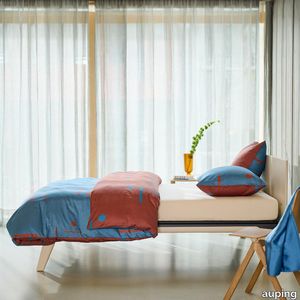
auping > Accessories
The Lively lucid pillowcases are made of 100% cotton satin. With this cotton satin pillowcase, you can give your bedroom two different looks. Will you go for the blue side with dark details, or give your bedroom a warmer look by choosing the brown side? Pillowcase with double hotel closureThe Auping pillowcases from the seasonal collection have what is known as a double hotel closure. A hotel closure is a folded opening on the shortest side of the pillowcase. With a double hotel closure, it doesn't matter which side of your pillow you use, it always looks neat.Sizes of our pillowcasesThe pillowcases from the basic collection and seasonal collection are also available as a loose set in sizes:60 x 70 cm40 x 60 cmSustainability At Auping, we dream of a rested world. Of sleeping under wonderful bedding made in an environmentally friendly way and under good working conditions. That's why all our duvet covers in the basic collection have the internationally recognised GOTS certificate. This is the very highest international standard for organic textiles. It not only guarantees top quality but also gives us the assurance that the entire chain complies with strict social and environmental requirements. The covers in the seasonal collection carry the BCI label, which also guarantees sustainably and socially responsible produced bed textiles.Quality labelsNot only sustainability but also the quality of our products is very important to us. We pay a lot of attention to this and work with the following quality marks and institutes to guarantee our quality. All Auping duvet covers are checked annually by TÜV Rheinland Netherlands for size, shrinkage, colour fastness and strength properties.All Auping duvet covers have the Oeko-Tex Standard 100 certificate. This quality mark is issued by the Oeko-Tex institute which guarantees that the tested and certified textiles are free of harmful substances in relation to human health and environmental impact. It is thus a safety seal for textiles.
ANDERSEN - Fabric sofa bed_ Milano Bedding
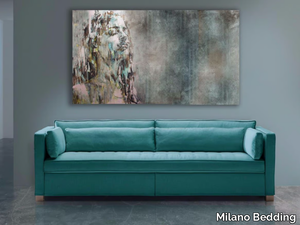
Milano Bedding > Sofa
ANDERSEN by Milano Bedding – Classic Lines, Daily Comfort, and Italian Craftsmanship Name: Andersen Material: Solid wood frame, polyurethane foam, steel Lampolet mechanism Finishing: Fixed or removable fabric/leather upholstery, wooden or metal feet Sizes (cm): Width 180–210 | Depth 100 | Height 83 | Bed size 140×200 or 160×200 Weight: Approx. 110–125 kg Designed in: Italy Collection: Milano Bedding Sofa Beds Lead Time: 30 days 2D/3D Files: Available for download Timeless Style with Hidden Functionality The Andersen sofa bed by Milano Bedding is a harmonious blend of classic proportions, tailored detailing, and everyday comfort. Its straight arms, structured cushions, and timeless silhouette make it a versatile solution for elegant hospitality spaces, refined homes, and serviced apartments. Behind its refined appearance lies a true Milano Bedding innovation: a 17 cm thick mattress that unfolds with the Lampolet mechanism into a full-size bed—without removing seat or back cushions. Ideal for daily use, the Andersen ensures that comfort and aesthetics go hand in hand. Structure, Upholstery & Detailing The Andersen features a solid wood frame, built to last in high-traffic environments like hotels and short-stay accommodations. Its multi-density polyurethane foam cushions provide lasting support and comfort, retaining their shape over time. Upholstery is available in both fixed or removable fabric or leather options, with Milano Bedding’s curated range of timeless textures: smooth cottons, wool blends, tactile bouclé, high-performance weaves, and natural linens. The piping detail on the arms and seat cushions adds structure and refinement. You can choose between classic wooden legs (for a more traditional look) or slim metal legs (for a contemporary edge), depending on the project style. Perfect for Residential, Hospitality & Contract Use The Andersen is a great fit for: Hotel rooms, suites, and short-stay apartments Guest bedrooms or home libraries Serviced apartments and co-living units Executive lounges or reception spaces Transitional or modern-classic interiors that require flexibility Its elegant proportions and removable upholstery make it ideal for spaces that require a balance of formality, durability, and multi-functionality. Style Notes & Interior Fit Visually, Andersen sits comfortably in modern classic, transitional, or tailored Scandinavian interiors. Its clean structure and understated character allow it to blend seamlessly with both minimalist and decorative spaces. Whether styled in soft neutral tones for a calming palette or dressed in rich velvet or leather for a more luxurious feel, Andersen adapts effortlessly. It complements both traditional wood-panelled rooms and modern, minimalist apartments. Features & Options Mattress sizes: 140×200 cm or 160×200 cm 17 cm thick mattress in polyurethane or memory foam Quick-open Lampolet mechanism – no cushion removal required Upholstery: Removable or fixed, depending on fabric Base options: Wooden legs or painted metal legs Optional add-ons: headrests, scatter cushions, bolsters Explore More Sofa Beds in This Style Looking for similar aesthetics with different proportions? Consider: Ellington – Slim, compact shape with tailored look Marsalis – Sharper, more architectural design Vivien – Curved arms and soft feminine lines Goodman – Clean geometry with a slightly more relaxed feel All models are delivered with 2D and 3D files, ideal for planning, BIM, and designer presentations. Andersen by Milano Bedding is a sofa bed that combines understated elegance, technical excellence, and versatile design—an easy choice for projects where classic design and daily practicality go hand in hand.
JEREMIE EVO - Sofa _ Milano Bedding
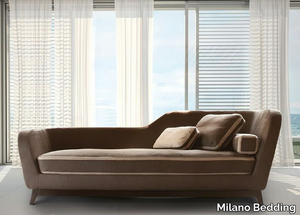
Milano Bedding > Sofa
JÉRÉMIE by Milano Bedding – Retro-Inspired Sofa Bed with Italian Craftsmanship Name: Jérémie Material: Solid wood frame, multi-density polyurethane foam, steel Lampolet mechanism Finishing: Fixed or removable fabric/leather upholstery with contrast piping, lacquered metal base Sizes (cm): Width 210 | Depth 100 | Height 84 | Bed size 140×200 Weight: Approx. 115–125 kg Designed in: Italy Collection: Milano Bedding Sofa Beds Lead Time: 30 days 2D/3D Files: Available for download Vintage Character with Hidden Bed Functionality The Jérémie by Milano Bedding is a unique sofa bed that blends retro curves, bold style, and true everyday comfort. Designed with a distinctive 1950s-inspired shape, it’s ideal for boutique hotels, residential interiors, and artistic short-stay apartments where character and functionality must coexist. Behind its sculptural back and gently sloped seat lies a hidden 140×200 cm bed with a 17 cm thick mattress—revealed using Milano Bedding’s patented Lampolet opening system, which requires no cushion removal. Craftsmanship, Materials & Finishes Jérémie is constructed with a solid wood frame and reinforced by a durable steel mechanism that supports regular use. The seat and back cushions are filled with multi-density polyurethane foam, offering ergonomic comfort and maintaining its refined shape over time. Its upholstery can be specified in a wide range of fabrics or leathers, with the option of contrast piping that outlines the frame and accentuates its silhouette. The seat’s unique curvature can be highlighted with colour-blocking or two-tone fabric pairings—ideal for creating a custom statement piece. The base is supported by a lacquered metal plinth, available in matt black or custom colours. Perfect for Artistic Hospitality & Characterful Interiors Jérémie is a standout choice for: Boutique hotels, creative B&Bs, or retro-inspired rentals Residential lounges, design apartments, or home libraries Lobbies or waiting rooms that call for statement seating Conceptual interiors with a mid-century or eclectic identity Its bold design makes it ideal where furniture plays a central visual role—not just in form, but in storytelling. Design Style & Visual Language Jérémie’s form draws clear influence from mid-century French and Italian design—with its slanted backrest, rounded seat, and piped contours. It bridges the gap between sculptural furniture and everyday utility, and fits perfectly in eclectic, retro-modern, or Art Deco-inspired interiors. When upholstered in velvet or textured wool, it delivers a luxurious lounge feel; when styled in bright tones or graphic prints, it becomes playful and eye-catching. Features & Customisation Options Converts into a 140×200 cm bed Includes a 17 cm thick mattress, in polyurethane or memory foam No cushion removal during opening Upholstery available with removable or fixed covers Contrast piping and two-tone configurations available on request Optional scatter cushions, headrests, or matching ottomans Alternative Sofa Beds with Character If you like Jérémie’s charm but want different styling, explore: Vivien – Feminine silhouette with curved armrests Marsalis – Sharper, mid-century proportions with architectural lines Clarke Quilted – Relaxed look with textural softness Ellington – Classic shape with compact footprint All Milano Bedding products include 2D and 3D files to assist in specification, planning, and visualisation. Jérémie by Milano Bedding is a design-forward sofa bed that delivers vintage soul and modern sleeping comfort, making it ideal for curated interiors where form and function must equally shine.
COSMO 1506 Sofa: A Modern Two-Seater Masterpiece
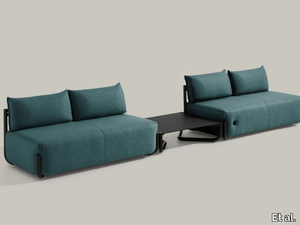
Et al. > Sofa
COSMO 1506 Sofa: A Modern Two-Seater Masterpiece The COSMO 1506 sofa, designed by Philippe Tabet for Et al., epitomizes contemporary elegance and versatility. This two-seater sofa, devoid of armrests, seamlessly integrates into various interior settings, including residential living rooms, hotel lounges, office waiting areas, and upscale retail spaces. Design and Dimensions The COSMO 1506 boasts a sleek and minimalist design, characterized by its armless structure and plush upholstery. Its dimensions are thoughtfully crafted to provide comfort while maintaining a compact footprint: Width: 150 cm Depth: 88 cm Height: 80 cm Seat Height: 44 cm These proportions make it an ideal choice for both spacious and limited areas, offering ample seating without overwhelming the space. Materials and Finishes Crafted with precision, the COSMO 1506 features: Frame: Constructed from durable steel tubing, ensuring stability and longevity. Upholstery: Available in a diverse range of high-quality fabrics, including options like Melva, Fortis, Inca, Medley Gabriel, Chili Gabriel, Mirage, Convert, Fenice, Mood Gabriel, Valencia, Fabthirthy Rubelli, Ocean Mastrotto, and Remix 3 Kvadrat, each offering multiple color choices to suit various design aesthetics. Frame Finishes: The steel frame can be customized in various finishes, such as White Aluminium (NCS S4000-N VR), Jet Black (NCS S9000-N VR), Coral Red (NCS S3060-Y80R), Matt Jet Black (NCS S9000-N VR), Rough Metallic Bronze (VR), Curry (NCS S3060-Y), Olive Green (NCS S7020-G50Y), Water Blue (NCS S4050-B40G), Capri Blue (NCS S6030-B), Brown (NCS S8005-Y20R), Traffic White (NCS S0502-B VR), Marsala (NCS S4040-R), Pewter (VR), Pure White (NCS S0500-N VR), and Anthracite Grey (NCS S7502-B VR), allowing for seamless integration into any interior color scheme. Functional Accessories To enhance its functionality, the COSMO 1506 can be equipped with optional accessories: Kidney Cushion: Provides additional lumbar support for increased comfort. Reading Lamp: An integrated light source suitable for reading or creating ambient lighting. USB Socket: Convenient for charging electronic devices, making it suitable for modern living and working environments. Schuko Socket: Offers an additional power outlet for various needs. These accessories make the sofa a practical choice for both relaxation and productivity. Applications and Versatility The COSMO 1506's adaptable design makes it suitable for a variety of settings: Residential Spaces: Ideal for living rooms or bedrooms, adding a touch of modern elegance. Hospitality Environments: Perfect for hotel lobbies, guest rooms, or lounge areas, offering comfort and style to guests. Office and Waiting Areas: Enhances reception spaces or private offices with its sleek design and optional functional accessories. Retail Spaces: Complements boutique stores or showrooms, providing a comfortable seating option for customers. Complementary Products The COSMO collection includes various seating solutions that can be paired with the 1506 sofa to create cohesive interior designs. Options include the COSMO 1505 armchair, the COSMO 1502 three-seater sofa, and modular systems like the COSMO 1520, allowing for flexible configurations to suit different spaces and requirements. Key Features Modern Aesthetic: Clean lines and armless design contribute to a minimalist and contemporary look. Customizable Finishes: Wide range of upholstery fabrics and frame finishes to match specific design requirements. Optional Accessories: Functional add-ons like reading lamps and USB sockets enhance usability. Compact Dimensions: Suitable for both large and small spaces without compromising on comfort. High-Quality Construction: Durable materials ensure longevity and sustained aesthetic appeal.
ARI 1314 - Square steel coffee table _ Et al.
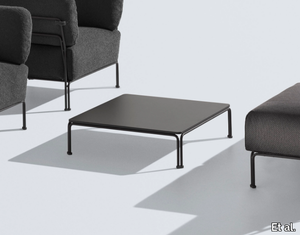
Et al. > Side table
Ari 1314 Coffee Table Module: Seamless Integration for Modern Spaces The Ari 1314 coffee table module, designed by Philippe Nigro for Et al., is a versatile addition to the Ari modular seating system. Its minimalist design and functional dimensions make it suitable for various environments, including residential living rooms, hotel lounges, office waiting areas, and outdoor settings. Design and Dimensions The Ari 1314 features a sleek steel frame supporting a 70x70 cm high-pressure laminate (HPL) top, offering both durability and elegance. Its height of 19 cm ensures a low-profile presence that complements the seating modules within the Ari collection. ET AL. Materials and Finishes Crafted with precision, the Ari 1314 offers a range of customization options to suit various design aesthetics: Frame: Constructed from durable steel tubing, ensuring stability and longevity. Top: Made from high-quality HPL laminate, known for its resistance to wear and ease of maintenance. Frame Finishes: The steel frame can be customized in various finishes, such as White Aluminium (NCS S4000-N VR), Jet Black (NCS S9000-N VR), Coral Red (NCS S3060-Y80R), Matt Jet Black (NCS S9000-N VR), Rough Metallic Bronze (VR), Curry (NCS S3060-Y), Olive Green (NCS S7020-G50Y), Water Blue (NCS S4050-B40G), Capri Blue (NCS S6030-B), Brown (NCS S8005-Y20R), Traffic White (NCS S0502-B VR), Marsala (NCS S4040-R), Pewter (VR), Pure White (NCS S0500-N VR), and Anthracite Grey (NCS S7502-B VR), allowing for seamless integration into any interior or exterior color scheme. ET AL. Applications and Versatility The Ari 1314's design makes it suitable for a variety of settings: Residential Spaces: Ideal for living rooms or patios, adding a touch of modern elegance. Hospitality Environments: Perfect for hotel lobbies, guest rooms, or lounge areas, offering functionality and style to guests. Office and Waiting Areas: Enhances reception spaces or private offices with its sleek design and compatibility with other Ari modules. Outdoor Settings: Designed to withstand outdoor conditions, making it suitable for terraces and garden areas. Complementary Products The Ari collection includes various modules that can be paired with the 1314 coffee table to create cohesive seating arrangements. Options include the Ari 1300 linear module, the Ari 1311 corner module, and the Ari 1313 pouf, allowing for flexible configurations to suit different spaces and requirements. Key Features Modular Design: Allows for customizable arrangements to fit various spaces. Modern Aesthetic: Clean lines and minimalist design contribute to a contemporary look. Customizable Finishes: Wide range of frame finishes to match specific design requirements. High-Quality Construction: Durable materials ensure longevity and sustained aesthetic appeal.
MERMAIDS
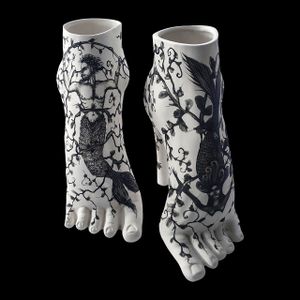
Elica Studio > Styling
MERMAIDS Material Porcelain, engobes, oxides Finishing Matte Sizes (cm) 281022 Weight (g) 900 Designed in 2020 Collection Anatomika Lead Time: 30 days The SIRENE is a sculptural porcelain object that channels the allure and mystery of the sea. Its rounded bell‑shaped body rises smoothly to a fluted crown of petal‑like protrusions, evoking mermaid fins or aquatic flora. At approximately 30 cm tall, its presence is both elegant and intimate—making it versatile for styling across varied interior environments. Shape & Concept The upward‑flaring, undulating rim contrasts with the smooth conical base—creating a sense of vertical movement and organic tension. The form suggests natural motifs—sea anemones, coral outgrowths, or mythical sirens—imbued with an abstract, contemporary sensibility. Colour & Surface Coated in a high‑gloss glaze, SIRENE glimmers like a polished pebble soaked in sunlight. The glossy finish accentuates its fluid contours while reflective highlights animate the form. Soft oxide washes settle into the recessed curves, creating tonal depth—from bright pearl on raised ridges to muted slate in crevices. Pattern & Detailing Close viewing reveals delicate surface irregularities—hand‑modelled ripples and subtle texture marks—that signal the maker’s hand. These slight imperfections add visual richness, making the piece feel alive and tactile rather than slick or mass‑produced. ✨ Styling Tips for Interior Designers Modern Minimalist Interiors: Showcase MERMAIDS solo on a white or marble console. Its glossy finish becomes a luminous focal point, especially under accent lighting. Scandinavian & Japandi Spaces: Combine with light timber and linen accents. The object’s organic shape complements pale, natural palettes and soft textures. Industrial & Monochrome Schemes: Set against dark concrete, metal, or black cabinetry to inject fluid form and gentle sheen into stark, structured spaces. Eclectic & Textural Rooms: Pair with matte ceramics, dried botanicals, or brass elements to balance drama with calm. The contrast creates a rich, layered vignette. Why Designers Choose MERMAIDS Tactile Contrast: Gloss meets organic form—creating visual drama that is engaging at arm’s length and beyond. Form & Function: Compact but sculpturally impactful—perfect for consoles, mantelpieces, shelves, or side tables. Artisanal Authenticity: Slight variations in glaze and hand‑formed edges ensure each piece is unique and expressive. Natural Narrative: Evokes water and myth—adding emotional resonance and storytelling potential within the space. Styling Tip: Light from the side or above to enhance the interplay of shine and shadow across its fluted rim. This lighting accentuates the three‑dimensional character and animates the surface with movement. In essence, MERMAIDS is more than décor—it’s a sculptural poem in porcelain. It brings organic elegance, reflective beauty, and emotional depth to interiors, making it an ideal accent for designers seeking refined yet expressive focal pieces.
Vivien - Milano-Bedding
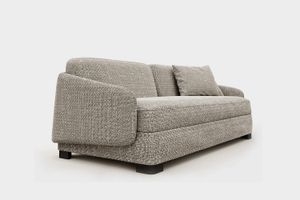
Milano Bedding > Sofa
VIVIEN by Milano Bedding – Feminine Elegance in a Sofa Bed with Hotel-Level Comfort Name: Vivien Material: Solid wood frame, polyurethane foam, steel Lampolet mechanism Finishing: Fixed or removable fabric or leather upholstery, painted metal legs Sizes (cm): Width 180–220 | Depth 100 | Height 82 | Bed size 140×200 or 160×200 Weight: Approx. 110–125 kg Designed in: Italy Collection: Milano Bedding Sofa Beds Lead Time: 30 days 2D/3D Files: Available for download Graceful Design with Smart Functionality The Vivien by Milano Bedding is a refined sofa bed that brings together softness, subtle curves, and a deeply feminine silhouette. Its compact proportions and elegant lines make it ideal for boutique hotels, luxury apartments, and residential guest rooms where style must meet performance. What sets Vivien apart is its gently curved armrests, slim frame, and tailored detailing—yet it houses a full 17 cm thick mattress inside. Thanks to the Lampolet mechanism, it converts effortlessly into a real bed, ideal for daily use, with no need to remove cushions. Build, Upholstery & Finishing Touches Vivien’s structure is made from solid wood, ensuring durability in contract environments. The cushions are crafted from high-resilience polyurethane foam, offering ergonomic support while maintaining a light, elegant appearance. It’s available in fixed or removable upholstery—including textured linens, soft velvets, wool blends, and smooth leathers. Choose soft pastel tones, creamy neutrals, or rich shades to adapt Vivien to your project’s atmosphere. Metal legs, finished in matt black or bronze, keep the look modern and minimal while adding lift and visual airiness. Perfect for Hospitality & Residential Projects Vivien is designed for spaces that need a compact, graceful sofa with true sleeping functionality, such as: Boutique hotel suites or high-end short-stay apartments Guest bedrooms or home libraries with dual use Luxury studio flats or co-living units Reception areas or VIP lounges where elegance is key Compact residential living rooms seeking sophistication and flexibility Its removable cover option makes it ideal for hospitality environments, where easy maintenance is essential. Style Direction and Interior Compatibility Vivien’s visual appeal lies in its curved armrests, slender back, and refined piping. The form is romantic but not ornate, and works well in Scandinavian, Japandi, or modern Parisian-style interiors. Styling options range from neutral and minimalist to warm and textural, depending on the selected fabric. It pairs beautifully with round coffee tables, layered rugs, and soft lighting—creating an inviting, boutique-hotel atmosphere. Specifications & Customisation Options Bed sizes: 140×200 cm or 160×200 cm Mattress height: 17 cm, available in polyurethane or memory foam Easy-to-open mechanism; no need to remove cushions Optional removable cover for convenience Matching scatter cushions and headrests available Explore Alternatives in the Collection If you love Vivien’s softness but are looking for different silhouettes, explore: Marsalis – Strong architectural lines and tailored feel Clarke Quilted – Relaxed with informal quilted upholstery Ellington – Classic proportions with compact form Jarreau – Bold volume and deep seat for high-impact design All products are available with 2D and 3D files, streamlining the specification process for interior designers and architects. Vivien by Milano Bedding is the ultimate blend of Italian elegance and smart functionality—a compact, luxurious sofa bed that brings lightness, charm, and true comfort to any space.
Charles - Sofa Bed_Milano Bedding
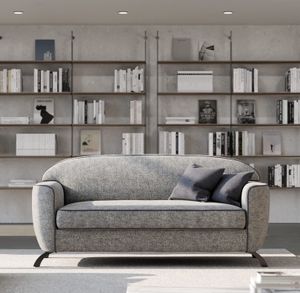
Milano Bedding > Sofa
CHARLES by Milano Bedding – Minimalist Sofa Bed with Linear Elegance and Integrated Comfort Name: Charles Material: Solid wood frame, polyurethane foam, steel Lampolet mechanism Finishing: Fixed or removable fabric/leather upholstery, slim metal legs Sizes (cm): Width 180–210 | Depth 100 | Height 85 | Bed size 140×200 or 160×200 Weight: Approx. 110–125 kg Designed in: Italy Collection: Milano Bedding Sofa Beds Lead Time: 30 days 2D/3D Files: Available for download Contemporary Simplicity with Integrated Sleeping Function The Charles by Milano Bedding is the go-to sofa bed for interiors that call for understated elegance, geometric precision, and true comfort. Designed with a clean, architectural silhouette, Charles features straight lines, minimal detailing, and a slim profile—making it ideal for urban apartments, contract lounges, boutique hotels, and guest-ready homes. Hidden within its streamlined form is a full 140×200 or 160×200 cm bed, with a 17 cm thick mattress and Milano Bedding’s patented Lampolet mechanism, allowing for daily use without removing seat or back cushions. Structure, Upholstery & Build Quality Charles is constructed with a solid wood frame and reinforced by a durable steel fold-out system, engineered for both residential and commercial use. The polyurethane foam seat and back cushions provide excellent support while maintaining a sleek, formal shape. Available in removable or fixed fabric and leather upholstery, Charles can be tailored in a wide variety of Milano Bedding textiles—from neutral wools and tactile linens to high-performance contract-grade fabrics. The slim metal legs, in matt black or custom finishes, give it a discreet lift and contemporary stance. Versatile for Compact & Elegant Interiors With its reduced depth and linear silhouette, Charles is perfect for: Hotel rooms and executive suites where space and elegance matter Serviced apartments, student housing, and short-stay rentals Guest rooms, home offices, or multi-functional living spaces Lobbies, reception areas, or workspace lounges in need of soft seating that converts into a bed Its minimalist design makes it a flexible match for many interior styles, especially where clean aesthetics and comfort must go hand in hand. Visual Language & Style Pairing Charles speaks the language of modern minimalism—sharp lines, crisp edges, and no unnecessary ornamentation. It fits seamlessly into Scandinavian, Japandi, urban industrial, and mid-century inspired interiors. Dress it in monochromatic tones for a sleek, tailored look, or add soft throws and scatter cushions to bring warmth and texture. Its timeless shape works equally well in neutral or colour-rich design schemes. Functional Highlights & Options Available as a 140×200 cm or 160×200 cm bed 17 cm thick mattress (polyurethane or memory foam) Quick-open mechanism with cushions attached Removable cover option for cleaning and reupholstery Add-ons: scatter cushions, bolsters, headrests, or matching ottoman Similar Sofa Beds in the Collection If you like the simplicity of Charles but need a different form, explore: Ellington – More classic in shape with narrow arms Goodman – Wider arms, generous seat, and similar architectural profile Marsalis – Mid-century elegance with tailored detailing Clarke Quilted – Relaxed feel with casual texture All models include 2D and 3D files, making it easy to integrate them into floorplans, renders, and technical drawings. Charles by Milano Bedding is a minimalist sofa bed that doesn’t shout but always delivers—perfect for stylish, compact interiors where clarity, comfort, and performance come first.
Matrice Traccia
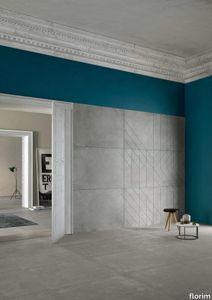
florim > Wallcovering
An atlas of modular signs to be combined in a wide variety of layouts. «We love concrete as a material, its versatility and its plain, austere look. We have completed our carefully designed surfaces with graphic patterning inspired by the human actions of weaving and embroidering.» Barbara Brondi & Marco Rainò To appreciate the profundity of the design project undertaken by Barbara Brondi and Marco Rainò for Cedit, it is both necessary and explanatory to start from the title the collection bears. In modern usage the term Matrice, in Italian, refers to a die or mould used to reproduce an object, but its origins are much more remote, with a meaning closer to the English “matrix”, meaning the underlying basis of something. The root of the word is related to Mater or mother: the name Matrice thus relates to the origin or cause of something. This dichotomy is expressed in several levels within the work of these architects, who study the world from a sophisticated conceptual approach and then transform it into a design. Starting from the idea of ceramic coverings, which have always been a tool not so much of architecture as of interior design, the artists work back to the origin of the surface and its decoration within their own discipline: they look at what we used to call the modern age, where modernity has also brought an uncompromising brutality, and where the use of bare concrete became the statement of an attitude to life with no time to spare for manners. Concrete is originally a liquid material, intended for shaping, which can therefore absorb and retain any type of mark created by the material and mould used to form it. Architects midway between rationalism and brutalism have used the rough-and-ready language of concrete combined with a last, elegant, anthropic decorative motif impressed on the material, that makes the concept of covering superfluous, because its place, in its older meaning of decoration rather than functional cladding, is taken by the regular patterning created in the material itself. There are therefore various grounds for believing that, in this collection, the artists are once again working in architectural terms. Firstly, with a simplicity typical of BRH+, they reduce the initial concepts to their minimal terms. So although this is a collection of coverings for walls, indoor floors, outdoor pavings and curtain walls, a great deal of time was spent on destructuring the idea of the ceramic covering itself. Unfortunately, nowadays there is no space in the contemporary construction sector for the radical approach of the past, so the cladding designed for the building actually lays bare the interior, using the choice of material – accurately interpreted (with shade variation) on the basis of an assortment of various types – to restore visual elegance and a fundamental severity. Attention to scale is another architectural feature: Matrice offers modules with architectural dimensions and different sizes through the development of “large slabs”, eliminating the visual regular grid effect. Thanks to this visual reset, geographic forms are perceived to emerge from dense, grey concrete surfaces decorated as in bygone days by special processes and by weathering during drying. The various types of slab, each an atlas of subtle, vibrant signs on the surfaces, comprise finishes that reproduce the visual effect of reinforced concrete – with the aggregates in the cement more clearly visible, of formwork – with the signs impressed on the concrete by the timber used, of a structured surface resembling bare cement plaster, of ridged and streaked surfaces – with patterning resembling some kinds of linear surface finishing processes – and finally a smooth, or basic version, over which Matrice exercises the dichotomy referred to earlier. It is on these surfaces that Brondi and Rainò have imagined additional design reverberations, a figurative code that rejects the concept of the grid, previously inseparable from that of the module: by means of a vocabulary of graphic marks cut into the slabs with a depth of 3 mm (the width of the gap left between modules during installation), they provide a framework for infinite combinations of possible dialogues. Just as in embroidery, which is based on grids of stitches and geometric repetitions, and where every stitch is at right-angles to another one to construct forms and decorations. Also taken from embroidery is the idea of introducing a degree of “softness” to reduce the stiffness of intentionally deaf surfaces. There is the impression of patterns that can continue for infinity, as in textile weaving, and a scale that, unlike the surface being worked on, is imagined as suspended and lightweight. They may not admit it, but BRH+ know a lot about music, including electronic music, and it appears to me that this organised tangle of infinite signs – unidentifiable without an overview – is rather like the representations of synthesized sounds. Sounds that are produced by machines, and thus “woven” by sampling and overlapping sounds of the most unlikely origins, combined to form jingles which, once heard, are imprinted indelibly on the brain. This may be why I am so interested in the space between this “melodic film” and its deaf, damp substrate. The eyes can navigate this suspended reality without fear of disturbance. So we are faced with different surfaces, different sizes and different graphic signs. But only one colour (surprise!) to prevent a cacophony not just of signs but also of possible interpretations: the artists retain their radical principles (and their generosity), and as curators, a role in which they are skilled, they leave the players (architects and installers) to add their own interpretations. In their hands this colour, expressed in Matrice, will produce motifs on surfaces in living spaces for someone else. This stylish covering and its workmanship will be left to the hands of someone who will probably never read this, but will be on a building site, with the radio playing on a stereo system, concentrating on installing the very pieces we describe. So a radical, apparently silent, design project like this has repercussions for the real world we live in. Matrice has no form of its own but merely acquires the ornamentation drawn on its surfaces by a second group of artists. And here this routine action, standardised by the form approved for production and workmanlike efficiency, is the origin and cause of change, generating a variability of choices and interpretations, on that dusty building site where music plays and mortar flows.
Matrice Forma

florim > Wallcovering
An atlas of modular signs to be combined in a wide variety of layouts. «We love concrete as a material, its versatility and its plain, austere look. We have completed our carefully designed surfaces with graphic patterning inspired by the human actions of weaving and embroidering.» Barbara Brondi & Marco Rainò To appreciate the profundity of the design project undertaken by Barbara Brondi and Marco Rainò for Cedit, it is both necessary and explanatory to start from the title the collection bears. In modern usage the term Matrice, in Italian, refers to a die or mould used to reproduce an object, but its origins are much more remote, with a meaning closer to the English “matrix”, meaning the underlying basis of something. The root of the word is related to Mater or mother: the name Matrice thus relates to the origin or cause of something. This dichotomy is expressed in several levels within the work of these architects, who study the world from a sophisticated conceptual approach and then transform it into a design. Starting from the idea of ceramic coverings, which have always been a tool not so much of architecture as of interior design, the artists work back to the origin of the surface and its decoration within their own discipline: they look at what we used to call the modern age, where modernity has also brought an uncompromising brutality, and where the use of bare concrete became the statement of an attitude to life with no time to spare for manners. Concrete is originally a liquid material, intended for shaping, which can therefore absorb and retain any type of mark created by the material and mould used to form it. Architects midway between rationalism and brutalism have used the rough-and-ready language of concrete combined with a last, elegant, anthropic decorative motif impressed on the material, that makes the concept of covering superfluous, because its place, in its older meaning of decoration rather than functional cladding, is taken by the regular patterning created in the material itself. There are therefore various grounds for believing that, in this collection, the artists are once again working in architectural terms. Firstly, with a simplicity typical of BRH+, they reduce the initial concepts to their minimal terms. So although this is a collection of coverings for walls, indoor floors, outdoor pavings and curtain walls, a great deal of time was spent on destructuring the idea of the ceramic covering itself. Unfortunately, nowadays there is no space in the contemporary construction sector for the radical approach of the past, so the cladding designed for the building actually lays bare the interior, using the choice of material – accurately interpreted (with shade variation) on the basis of an assortment of various types – to restore visual elegance and a fundamental severity. Attention to scale is another architectural feature: Matrice offers modules with architectural dimensions and different sizes through the development of “large slabs”, eliminating the visual regular grid effect. Thanks to this visual reset, geographic forms are perceived to emerge from dense, grey concrete surfaces decorated as in bygone days by special processes and by weathering during drying. The various types of slab, each an atlas of subtle, vibrant signs on the surfaces, comprise finishes that reproduce the visual effect of reinforced concrete – with the aggregates in the cement more clearly visible, of formwork – with the signs impressed on the concrete by the timber used, of a structured surface resembling bare cement plaster, of ridged and streaked surfaces – with patterning resembling some kinds of linear surface finishing processes – and finally a smooth, or basic version, over which Matrice exercises the dichotomy referred to earlier. It is on these surfaces that Brondi and Rainò have imagined additional design reverberations, a figurative code that rejects the concept of the grid, previously inseparable from that of the module: by means of a vocabulary of graphic marks cut into the slabs with a depth of 3 mm (the width of the gap left between modules during installation), they provide a framework for infinite combinations of possible dialogues. Just as in embroidery, which is based on grids of stitches and geometric repetitions, and where every stitch is at right-angles to another one to construct forms and decorations. Also taken from embroidery is the idea of introducing a degree of “softness” to reduce the stiffness of intentionally deaf surfaces. There is the impression of patterns that can continue for infinity, as in textile weaving, and a scale that, unlike the surface being worked on, is imagined as suspended and lightweight. They may not admit it, but BRH+ know a lot about music, including electronic music, and it appears to me that this organised tangle of infinite signs – unidentifiable without an overview – is rather like the representations of synthesized sounds. Sounds that are produced by machines, and thus “woven” by sampling and overlapping sounds of the most unlikely origins, combined to form jingles which, once heard, are imprinted indelibly on the brain. This may be why I am so interested in the space between this “melodic film” and its deaf, damp substrate. The eyes can navigate this suspended reality without fear of disturbance. So we are faced with different surfaces, different sizes and different graphic signs. But only one colour (surprise!) to prevent a cacophony not just of signs but also of possible interpretations: the artists retain their radical principles (and their generosity), and as curators, a role in which they are skilled, they leave the players (architects and installers) to add their own interpretations. In their hands this colour, expressed in Matrice, will produce motifs on surfaces in living spaces for someone else. This stylish covering and its workmanship will be left to the hands of someone who will probably never read this, but will be on a building site, with the radio playing on a stereo system, concentrating on installing the very pieces we describe. So a radical, apparently silent, design project like this has repercussions for the real world we live in. Matrice has no form of its own but merely acquires the ornamentation drawn on its surfaces by a second group of artists. And here this routine action, standardised by the form approved for production and workmanlike efficiency, is the origin and cause of change, generating a variability of choices and interpretations, on that dusty building site where music plays and mortar flows.
Matrice Rilievo

florim > Wallcovering
An atlas of modular signs to be combined in a wide variety of layouts. «We love concrete as a material, its versatility and its plain, austere look. We have completed our carefully designed surfaces with graphic patterning inspired by the human actions of weaving and embroidering.» Barbara Brondi & Marco Rainò To appreciate the profundity of the design project undertaken by Barbara Brondi and Marco Rainò for Cedit, it is both necessary and explanatory to start from the title the collection bears. In modern usage the term Matrice, in Italian, refers to a die or mould used to reproduce an object, but its origins are much more remote, with a meaning closer to the English “matrix”, meaning the underlying basis of something. The root of the word is related to Mater or mother: the name Matrice thus relates to the origin or cause of something. This dichotomy is expressed in several levels within the work of these architects, who study the world from a sophisticated conceptual approach and then transform it into a design. Starting from the idea of ceramic coverings, which have always been a tool not so much of architecture as of interior design, the artists work back to the origin of the surface and its decoration within their own discipline: they look at what we used to call the modern age, where modernity has also brought an uncompromising brutality, and where the use of bare concrete became the statement of an attitude to life with no time to spare for manners. Concrete is originally a liquid material, intended for shaping, which can therefore absorb and retain any type of mark created by the material and mould used to form it. Architects midway between rationalism and brutalism have used the rough-and-ready language of concrete combined with a last, elegant, anthropic decorative motif impressed on the material, that makes the concept of covering superfluous, because its place, in its older meaning of decoration rather than functional cladding, is taken by the regular patterning created in the material itself. There are therefore various grounds for believing that, in this collection, the artists are once again working in architectural terms. Firstly, with a simplicity typical of BRH+, they reduce the initial concepts to their minimal terms. So although this is a collection of coverings for walls, indoor floors, outdoor pavings and curtain walls, a great deal of time was spent on destructuring the idea of the ceramic covering itself. Unfortunately, nowadays there is no space in the contemporary construction sector for the radical approach of the past, so the cladding designed for the building actually lays bare the interior, using the choice of material – accurately interpreted (with shade variation) on the basis of an assortment of various types – to restore visual elegance and a fundamental severity. Attention to scale is another architectural feature: Matrice offers modules with architectural dimensions and different sizes through the development of “large slabs”, eliminating the visual regular grid effect. Thanks to this visual reset, geographic forms are perceived to emerge from dense, grey concrete surfaces decorated as in bygone days by special processes and by weathering during drying. The various types of slab, each an atlas of subtle, vibrant signs on the surfaces, comprise finishes that reproduce the visual effect of reinforced concrete – with the aggregates in the cement more clearly visible, of formwork – with the signs impressed on the concrete by the timber used, of a structured surface resembling bare cement plaster, of ridged and streaked surfaces – with patterning resembling some kinds of linear surface finishing processes – and finally a smooth, or basic version, over which Matrice exercises the dichotomy referred to earlier. It is on these surfaces that Brondi and Rainò have imagined additional design reverberations, a figurative code that rejects the concept of the grid, previously inseparable from that of the module: by means of a vocabulary of graphic marks cut into the slabs with a depth of 3 mm (the width of the gap left between modules during installation), they provide a framework for infinite combinations of possible dialogues. Just as in embroidery, which is based on grids of stitches and geometric repetitions, and where every stitch is at right-angles to another one to construct forms and decorations. Also taken from embroidery is the idea of introducing a degree of “softness” to reduce the stiffness of intentionally deaf surfaces. There is the impression of patterns that can continue for infinity, as in textile weaving, and a scale that, unlike the surface being worked on, is imagined as suspended and lightweight. They may not admit it, but BRH+ know a lot about music, including electronic music, and it appears to me that this organised tangle of infinite signs – unidentifiable without an overview – is rather like the representations of synthesized sounds. Sounds that are produced by machines, and thus “woven” by sampling and overlapping sounds of the most unlikely origins, combined to form jingles which, once heard, are imprinted indelibly on the brain. This may be why I am so interested in the space between this “melodic film” and its deaf, damp substrate. The eyes can navigate this suspended reality without fear of disturbance. So we are faced with different surfaces, different sizes and different graphic signs. But only one colour (surprise!) to prevent a cacophony not just of signs but also of possible interpretations: the artists retain their radical principles (and their generosity), and as curators, a role in which they are skilled, they leave the players (architects and installers) to add their own interpretations. In their hands this colour, expressed in Matrice, will produce motifs on surfaces in living spaces for someone else. This stylish covering and its workmanship will be left to the hands of someone who will probably never read this, but will be on a building site, with the radio playing on a stereo system, concentrating on installing the very pieces we describe. So a radical, apparently silent, design project like this has repercussions for the real world we live in. Matrice has no form of its own but merely acquires the ornamentation drawn on its surfaces by a second group of artists. And here this routine action, standardised by the form approved for production and workmanlike efficiency, is the origin and cause of change, generating a variability of choices and interpretations, on that dusty building site where music plays and mortar flows.
Matrice Sostanza

florim > Wallcovering
An atlas of modular signs to be combined in a wide variety of layouts. «We love concrete as a material, its versatility and its plain, austere look. We have completed our carefully designed surfaces with graphic patterning inspired by the human actions of weaving and embroidering.» Barbara Brondi & Marco Rainò To appreciate the profundity of the design project undertaken by Barbara Brondi and Marco Rainò for Cedit, it is both necessary and explanatory to start from the title the collection bears. In modern usage the term Matrice, in Italian, refers to a die or mould used to reproduce an object, but its origins are much more remote, with a meaning closer to the English “matrix”, meaning the underlying basis of something. The root of the word is related to Mater or mother: the name Matrice thus relates to the origin or cause of something. This dichotomy is expressed in several levels within the work of these architects, who study the world from a sophisticated conceptual approach and then transform it into a design. Starting from the idea of ceramic coverings, which have always been a tool not so much of architecture as of interior design, the artists work back to the origin of the surface and its decoration within their own discipline: they look at what we used to call the modern age, where modernity has also brought an uncompromising brutality, and where the use of bare concrete became the statement of an attitude to life with no time to spare for manners. Concrete is originally a liquid material, intended for shaping, which can therefore absorb and retain any type of mark created by the material and mould used to form it. Architects midway between rationalism and brutalism have used the rough-and-ready language of concrete combined with a last, elegant, anthropic decorative motif impressed on the material, that makes the concept of covering superfluous, because its place, in its older meaning of decoration rather than functional cladding, is taken by the regular patterning created in the material itself. There are therefore various grounds for believing that, in this collection, the artists are once again working in architectural terms. Firstly, with a simplicity typical of BRH+, they reduce the initial concepts to their minimal terms. So although this is a collection of coverings for walls, indoor floors, outdoor pavings and curtain walls, a great deal of time was spent on destructuring the idea of the ceramic covering itself. Unfortunately, nowadays there is no space in the contemporary construction sector for the radical approach of the past, so the cladding designed for the building actually lays bare the interior, using the choice of material – accurately interpreted (with shade variation) on the basis of an assortment of various types – to restore visual elegance and a fundamental severity. Attention to scale is another architectural feature: Matrice offers modules with architectural dimensions and different sizes through the development of “large slabs”, eliminating the visual regular grid effect. Thanks to this visual reset, geographic forms are perceived to emerge from dense, grey concrete surfaces decorated as in bygone days by special processes and by weathering during drying. The various types of slab, each an atlas of subtle, vibrant signs on the surfaces, comprise finishes that reproduce the visual effect of reinforced concrete – with the aggregates in the cement more clearly visible, of formwork – with the signs impressed on the concrete by the timber used, of a structured surface resembling bare cement plaster, of ridged and streaked surfaces – with patterning resembling some kinds of linear surface finishing processes – and finally a smooth, or basic version, over which Matrice exercises the dichotomy referred to earlier. It is on these surfaces that Brondi and Rainò have imagined additional design reverberations, a figurative code that rejects the concept of the grid, previously inseparable from that of the module: by means of a vocabulary of graphic marks cut into the slabs with a depth of 3 mm (the width of the gap left between modules during installation), they provide a framework for infinite combinations of possible dialogues. Just as in embroidery, which is based on grids of stitches and geometric repetitions, and where every stitch is at right-angles to another one to construct forms and decorations. Also taken from embroidery is the idea of introducing a degree of “softness” to reduce the stiffness of intentionally deaf surfaces. There is the impression of patterns that can continue for infinity, as in textile weaving, and a scale that, unlike the surface being worked on, is imagined as suspended and lightweight. They may not admit it, but BRH+ know a lot about music, including electronic music, and it appears to me that this organised tangle of infinite signs – unidentifiable without an overview – is rather like the representations of synthesized sounds. Sounds that are produced by machines, and thus “woven” by sampling and overlapping sounds of the most unlikely origins, combined to form jingles which, once heard, are imprinted indelibly on the brain. This may be why I am so interested in the space between this “melodic film” and its deaf, damp substrate. The eyes can navigate this suspended reality without fear of disturbance. So we are faced with different surfaces, different sizes and different graphic signs. But only one colour (surprise!) to prevent a cacophony not just of signs but also of possible interpretations: the artists retain their radical principles (and their generosity), and as curators, a role in which they are skilled, they leave the players (architects and installers) to add their own interpretations. In their hands this colour, expressed in Matrice, will produce motifs on surfaces in living spaces for someone else. This stylish covering and its workmanship will be left to the hands of someone who will probably never read this, but will be on a building site, with the radio playing on a stereo system, concentrating on installing the very pieces we describe. So a radical, apparently silent, design project like this has repercussions for the real world we live in. Matrice has no form of its own but merely acquires the ornamentation drawn on its surfaces by a second group of artists. And here this routine action, standardised by the form approved for production and workmanlike efficiency, is the origin and cause of change, generating a variability of choices and interpretations, on that dusty building site where music plays and mortar flows.
Matrice Aura

florim > Wallcovering
An atlas of modular signs to be combined in a wide variety of layouts. «We love concrete as a material, its versatility and its plain, austere look. We have completed our carefully designed surfaces with graphic patterning inspired by the human actions of weaving and embroidering.» Barbara Brondi & Marco Rainò To appreciate the profundity of the design project undertaken by Barbara Brondi and Marco Rainò for Cedit, it is both necessary and explanatory to start from the title the collection bears. In modern usage the term Matrice, in Italian, refers to a die or mould used to reproduce an object, but its origins are much more remote, with a meaning closer to the English “matrix”, meaning the underlying basis of something. The root of the word is related to Mater or mother: the name Matrice thus relates to the origin or cause of something. This dichotomy is expressed in several levels within the work of these architects, who study the world from a sophisticated conceptual approach and then transform it into a design. Starting from the idea of ceramic coverings, which have always been a tool not so much of architecture as of interior design, the artists work back to the origin of the surface and its decoration within their own discipline: they look at what we used to call the modern age, where modernity has also brought an uncompromising brutality, and where the use of bare concrete became the statement of an attitude to life with no time to spare for manners. Concrete is originally a liquid material, intended for shaping, which can therefore absorb and retain any type of mark created by the material and mould used to form it. Architects midway between rationalism and brutalism have used the rough-and-ready language of concrete combined with a last, elegant, anthropic decorative motif impressed on the material, that makes the concept of covering superfluous, because its place, in its older meaning of decoration rather than functional cladding, is taken by the regular patterning created in the material itself. There are therefore various grounds for believing that, in this collection, the artists are once again working in architectural terms. Firstly, with a simplicity typical of BRH+, they reduce the initial concepts to their minimal terms. So although this is a collection of coverings for walls, indoor floors, outdoor pavings and curtain walls, a great deal of time was spent on destructuring the idea of the ceramic covering itself. Unfortunately, nowadays there is no space in the contemporary construction sector for the radical approach of the past, so the cladding designed for the building actually lays bare the interior, using the choice of material – accurately interpreted (with shade variation) on the basis of an assortment of various types – to restore visual elegance and a fundamental severity. Attention to scale is another architectural feature: Matrice offers modules with architectural dimensions and different sizes through the development of “large slabs”, eliminating the visual regular grid effect. Thanks to this visual reset, geographic forms are perceived to emerge from dense, grey concrete surfaces decorated as in bygone days by special processes and by weathering during drying. The various types of slab, each an atlas of subtle, vibrant signs on the surfaces, comprise finishes that reproduce the visual effect of reinforced concrete – with the aggregates in the cement more clearly visible, of formwork – with the signs impressed on the concrete by the timber used, of a structured surface resembling bare cement plaster, of ridged and streaked surfaces – with patterning resembling some kinds of linear surface finishing processes – and finally a smooth, or basic version, over which Matrice exercises the dichotomy referred to earlier. It is on these surfaces that Brondi and Rainò have imagined additional design reverberations, a figurative code that rejects the concept of the grid, previously inseparable from that of the module: by means of a vocabulary of graphic marks cut into the slabs with a depth of 3 mm (the width of the gap left between modules during installation), they provide a framework for infinite combinations of possible dialogues. Just as in embroidery, which is based on grids of stitches and geometric repetitions, and where every stitch is at right-angles to another one to construct forms and decorations. Also taken from embroidery is the idea of introducing a degree of “softness” to reduce the stiffness of intentionally deaf surfaces. There is the impression of patterns that can continue for infinity, as in textile weaving, and a scale that, unlike the surface being worked on, is imagined as suspended and lightweight. They may not admit it, but BRH+ know a lot about music, including electronic music, and it appears to me that this organised tangle of infinite signs – unidentifiable without an overview – is rather like the representations of synthesized sounds. Sounds that are produced by machines, and thus “woven” by sampling and overlapping sounds of the most unlikely origins, combined to form jingles which, once heard, are imprinted indelibly on the brain. This may be why I am so interested in the space between this “melodic film” and its deaf, damp substrate. The eyes can navigate this suspended reality without fear of disturbance. So we are faced with different surfaces, different sizes and different graphic signs. But only one colour (surprise!) to prevent a cacophony not just of signs but also of possible interpretations: the artists retain their radical principles (and their generosity), and as curators, a role in which they are skilled, they leave the players (architects and installers) to add their own interpretations. In their hands this colour, expressed in Matrice, will produce motifs on surfaces in living spaces for someone else. This stylish covering and its workmanship will be left to the hands of someone who will probably never read this, but will be on a building site, with the radio playing on a stereo system, concentrating on installing the very pieces we describe. So a radical, apparently silent, design project like this has repercussions for the real world we live in. Matrice has no form of its own but merely acquires the ornamentation drawn on its surfaces by a second group of artists. And here this routine action, standardised by the form approved for production and workmanlike efficiency, is the origin and cause of change, generating a variability of choices and interpretations, on that dusty building site where music plays and mortar flows.
Matrice Essenza

florim > Wallcovering
An atlas of modular signs to be combined in a wide variety of layouts. «We love concrete as a material, its versatility and its plain, austere look. We have completed our carefully designed surfaces with graphic patterning inspired by the human actions of weaving and embroidering.» Barbara Brondi & Marco Rainò To appreciate the profundity of the design project undertaken by Barbara Brondi and Marco Rainò for Cedit, it is both necessary and explanatory to start from the title the collection bears. In modern usage the term Matrice, in Italian, refers to a die or mould used to reproduce an object, but its origins are much more remote, with a meaning closer to the English “matrix”, meaning the underlying basis of something. The root of the word is related to Mater or mother: the name Matrice thus relates to the origin or cause of something. This dichotomy is expressed in several levels within the work of these architects, who study the world from a sophisticated conceptual approach and then transform it into a design. Starting from the idea of ceramic coverings, which have always been a tool not so much of architecture as of interior design, the artists work back to the origin of the surface and its decoration within their own discipline: they look at what we used to call the modern age, where modernity has also brought an uncompromising brutality, and where the use of bare concrete became the statement of an attitude to life with no time to spare for manners. Concrete is originally a liquid material, intended for shaping, which can therefore absorb and retain any type of mark created by the material and mould used to form it. Architects midway between rationalism and brutalism have used the rough-and-ready language of concrete combined with a last, elegant, anthropic decorative motif impressed on the material, that makes the concept of covering superfluous, because its place, in its older meaning of decoration rather than functional cladding, is taken by the regular patterning created in the material itself. There are therefore various grounds for believing that, in this collection, the artists are once again working in architectural terms. Firstly, with a simplicity typical of BRH+, they reduce the initial concepts to their minimal terms. So although this is a collection of coverings for walls, indoor floors, outdoor pavings and curtain walls, a great deal of time was spent on destructuring the idea of the ceramic covering itself. Unfortunately, nowadays there is no space in the contemporary construction sector for the radical approach of the past, so the cladding designed for the building actually lays bare the interior, using the choice of material – accurately interpreted (with shade variation) on the basis of an assortment of various types – to restore visual elegance and a fundamental severity. Attention to scale is another architectural feature: Matrice offers modules with architectural dimensions and different sizes through the development of “large slabs”, eliminating the visual regular grid effect. Thanks to this visual reset, geographic forms are perceived to emerge from dense, grey concrete surfaces decorated as in bygone days by special processes and by weathering during drying. The various types of slab, each an atlas of subtle, vibrant signs on the surfaces, comprise finishes that reproduce the visual effect of reinforced concrete – with the aggregates in the cement more clearly visible, of formwork – with the signs impressed on the concrete by the timber used, of a structured surface resembling bare cement plaster, of ridged and streaked surfaces – with patterning resembling some kinds of linear surface finishing processes – and finally a smooth, or basic version, over which Matrice exercises the dichotomy referred to earlier. It is on these surfaces that Brondi and Rainò have imagined additional design reverberations, a figurative code that rejects the concept of the grid, previously inseparable from that of the module: by means of a vocabulary of graphic marks cut into the slabs with a depth of 3 mm (the width of the gap left between modules during installation), they provide a framework for infinite combinations of possible dialogues. Just as in embroidery, which is based on grids of stitches and geometric repetitions, and where every stitch is at right-angles to another one to construct forms and decorations. Also taken from embroidery is the idea of introducing a degree of “softness” to reduce the stiffness of intentionally deaf surfaces. There is the impression of patterns that can continue for infinity, as in textile weaving, and a scale that, unlike the surface being worked on, is imagined as suspended and lightweight. They may not admit it, but BRH+ know a lot about music, including electronic music, and it appears to me that this organised tangle of infinite signs – unidentifiable without an overview – is rather like the representations of synthesized sounds. Sounds that are produced by machines, and thus “woven” by sampling and overlapping sounds of the most unlikely origins, combined to form jingles which, once heard, are imprinted indelibly on the brain. This may be why I am so interested in the space between this “melodic film” and its deaf, damp substrate. The eyes can navigate this suspended reality without fear of disturbance. So we are faced with different surfaces, different sizes and different graphic signs. But only one colour (surprise!) to prevent a cacophony not just of signs but also of possible interpretations: the artists retain their radical principles (and their generosity), and as curators, a role in which they are skilled, they leave the players (architects and installers) to add their own interpretations. In their hands this colour, expressed in Matrice, will produce motifs on surfaces in living spaces for someone else. This stylish covering and its workmanship will be left to the hands of someone who will probably never read this, but will be on a building site, with the radio playing on a stereo system, concentrating on installing the very pieces we describe. So a radical, apparently silent, design project like this has repercussions for the real world we live in. Matrice has no form of its own but merely acquires the ornamentation drawn on its surfaces by a second group of artists. And here this routine action, standardised by the form approved for production and workmanlike efficiency, is the origin and cause of change, generating a variability of choices and interpretations, on that dusty building site where music plays and mortar flows.
Matrice Struttura

florim > Wallcovering
An atlas of modular signs to be combined in a wide variety of layouts. «We love concrete as a material, its versatility and its plain, austere look. We have completed our carefully designed surfaces with graphic patterning inspired by the human actions of weaving and embroidering.» Barbara Brondi & Marco Rainò To appreciate the profundity of the design project undertaken by Barbara Brondi and Marco Rainò for Cedit, it is both necessary and explanatory to start from the title the collection bears. In modern usage the term Matrice, in Italian, refers to a die or mould used to reproduce an object, but its origins are much more remote, with a meaning closer to the English “matrix”, meaning the underlying basis of something. The root of the word is related to Mater or mother: the name Matrice thus relates to the origin or cause of something. This dichotomy is expressed in several levels within the work of these architects, who study the world from a sophisticated conceptual approach and then transform it into a design. Starting from the idea of ceramic coverings, which have always been a tool not so much of architecture as of interior design, the artists work back to the origin of the surface and its decoration within their own discipline: they look at what we used to call the modern age, where modernity has also brought an uncompromising brutality, and where the use of bare concrete became the statement of an attitude to life with no time to spare for manners. Concrete is originally a liquid material, intended for shaping, which can therefore absorb and retain any type of mark created by the material and mould used to form it. Architects midway between rationalism and brutalism have used the rough-and-ready language of concrete combined with a last, elegant, anthropic decorative motif impressed on the material, that makes the concept of covering superfluous, because its place, in its older meaning of decoration rather than functional cladding, is taken by the regular patterning created in the material itself. There are therefore various grounds for believing that, in this collection, the artists are once again working in architectural terms. Firstly, with a simplicity typical of BRH+, they reduce the initial concepts to their minimal terms. So although this is a collection of coverings for walls, indoor floors, outdoor pavings and curtain walls, a great deal of time was spent on destructuring the idea of the ceramic covering itself. Unfortunately, nowadays there is no space in the contemporary construction sector for the radical approach of the past, so the cladding designed for the building actually lays bare the interior, using the choice of material – accurately interpreted (with shade variation) on the basis of an assortment of various types – to restore visual elegance and a fundamental severity. Attention to scale is another architectural feature: Matrice offers modules with architectural dimensions and different sizes through the development of “large slabs”, eliminating the visual regular grid effect. Thanks to this visual reset, geographic forms are perceived to emerge from dense, grey concrete surfaces decorated as in bygone days by special processes and by weathering during drying. The various types of slab, each an atlas of subtle, vibrant signs on the surfaces, comprise finishes that reproduce the visual effect of reinforced concrete – with the aggregates in the cement more clearly visible, of formwork – with the signs impressed on the concrete by the timber used, of a structured surface resembling bare cement plaster, of ridged and streaked surfaces – with patterning resembling some kinds of linear surface finishing processes – and finally a smooth, or basic version, over which Matrice exercises the dichotomy referred to earlier. It is on these surfaces that Brondi and Rainò have imagined additional design reverberations, a figurative code that rejects the concept of the grid, previously inseparable from that of the module: by means of a vocabulary of graphic marks cut into the slabs with a depth of 3 mm (the width of the gap left between modules during installation), they provide a framework for infinite combinations of possible dialogues. Just as in embroidery, which is based on grids of stitches and geometric repetitions, and where every stitch is at right-angles to another one to construct forms and decorations. Also taken from embroidery is the idea of introducing a degree of “softness” to reduce the stiffness of intentionally deaf surfaces. There is the impression of patterns that can continue for infinity, as in textile weaving, and a scale that, unlike the surface being worked on, is imagined as suspended and lightweight. They may not admit it, but BRH+ know a lot about music, including electronic music, and it appears to me that this organised tangle of infinite signs – unidentifiable without an overview – is rather like the representations of synthesized sounds. Sounds that are produced by machines, and thus “woven” by sampling and overlapping sounds of the most unlikely origins, combined to form jingles which, once heard, are imprinted indelibly on the brain. This may be why I am so interested in the space between this “melodic film” and its deaf, damp substrate. The eyes can navigate this suspended reality without fear of disturbance. So we are faced with different surfaces, different sizes and different graphic signs. But only one colour (surprise!) to prevent a cacophony not just of signs but also of possible interpretations: the artists retain their radical principles (and their generosity), and as curators, a role in which they are skilled, they leave the players (architects and installers) to add their own interpretations. In their hands this colour, expressed in Matrice, will produce motifs on surfaces in living spaces for someone else. This stylish covering and its workmanship will be left to the hands of someone who will probably never read this, but will be on a building site, with the radio playing on a stereo system, concentrating on installing the very pieces we describe. So a radical, apparently silent, design project like this has repercussions for the real world we live in. Matrice has no form of its own but merely acquires the ornamentation drawn on its surfaces by a second group of artists. And here this routine action, standardised by the form approved for production and workmanlike efficiency, is the origin and cause of change, generating a variability of choices and interpretations, on that dusty building site where music plays and mortar flows.